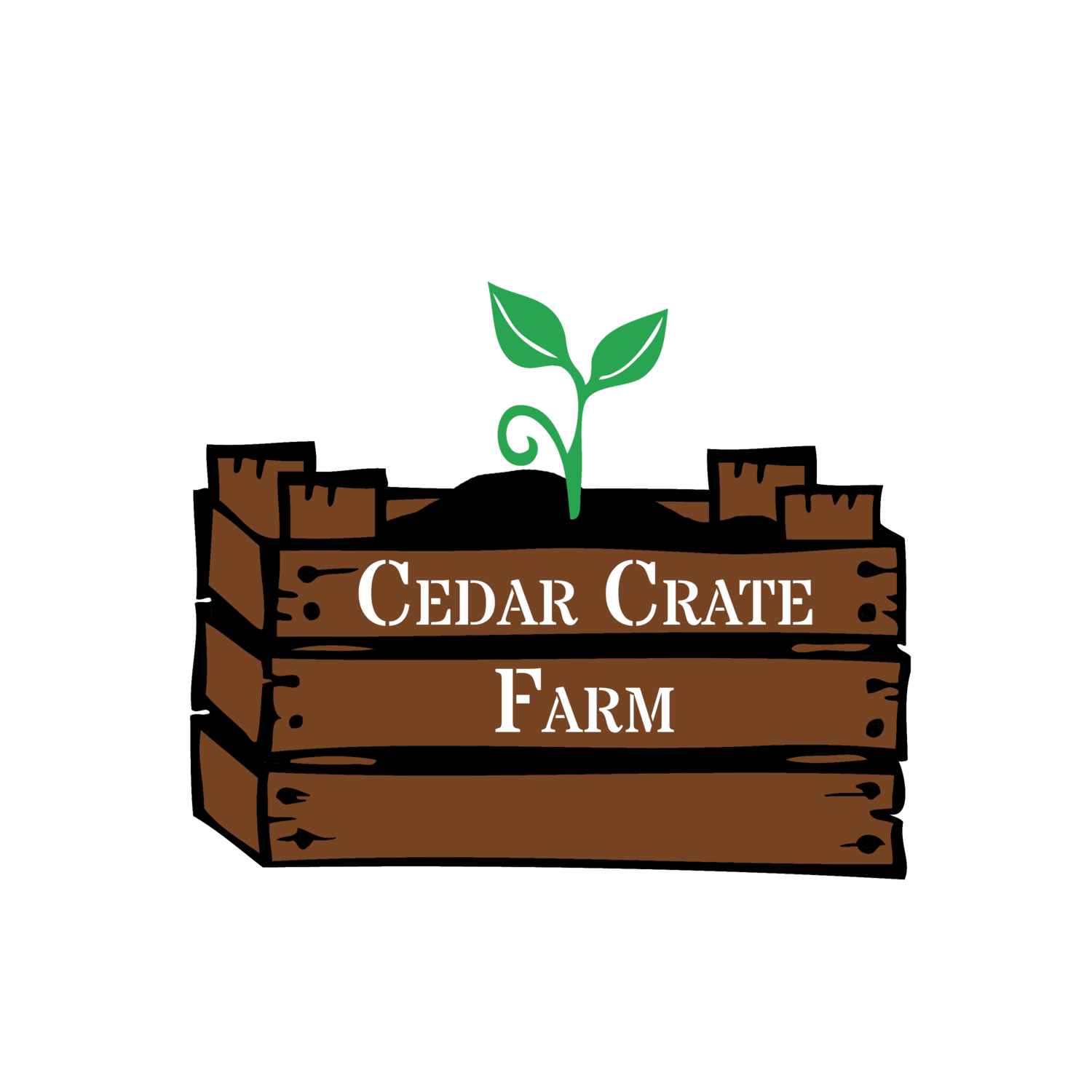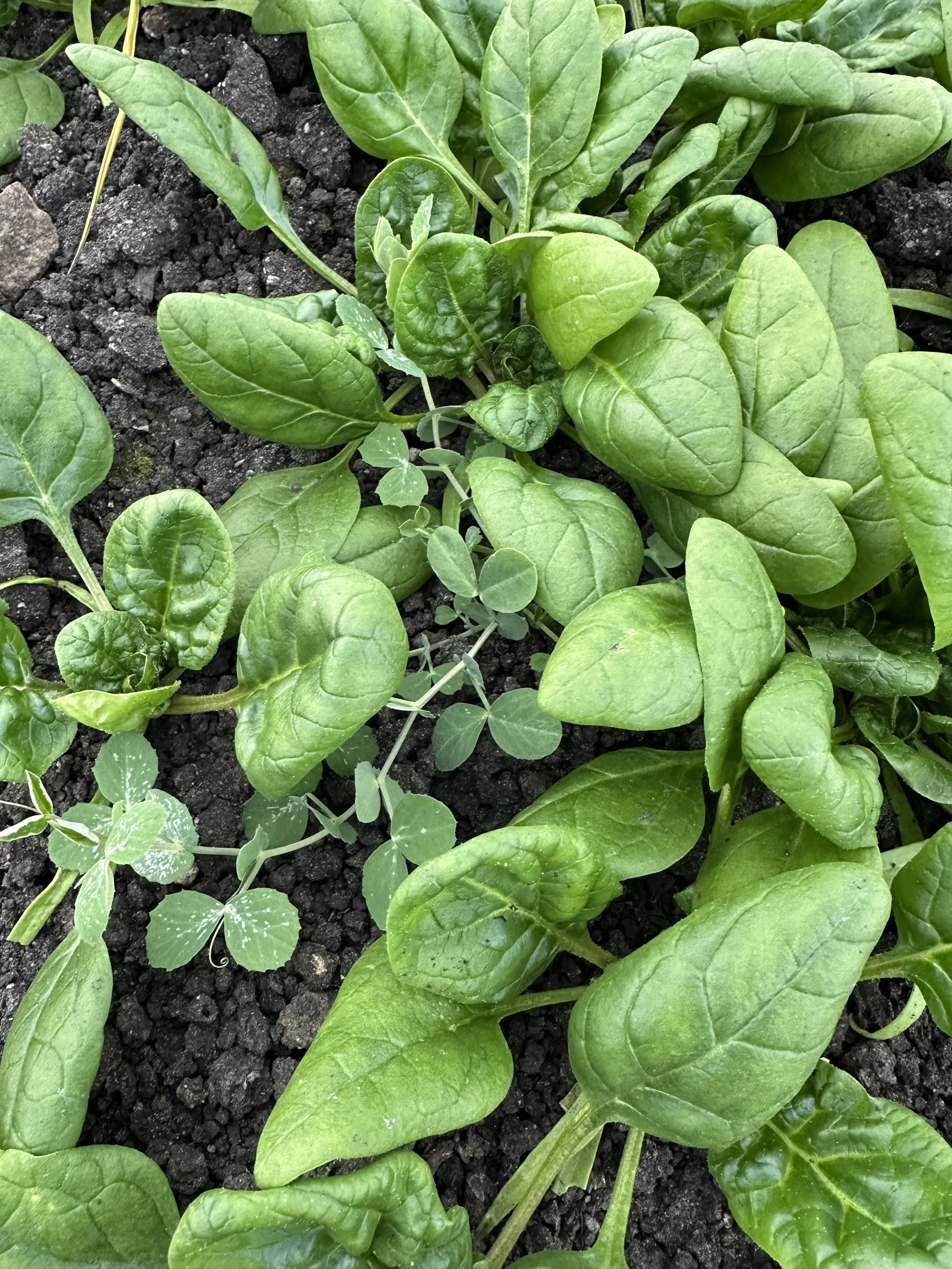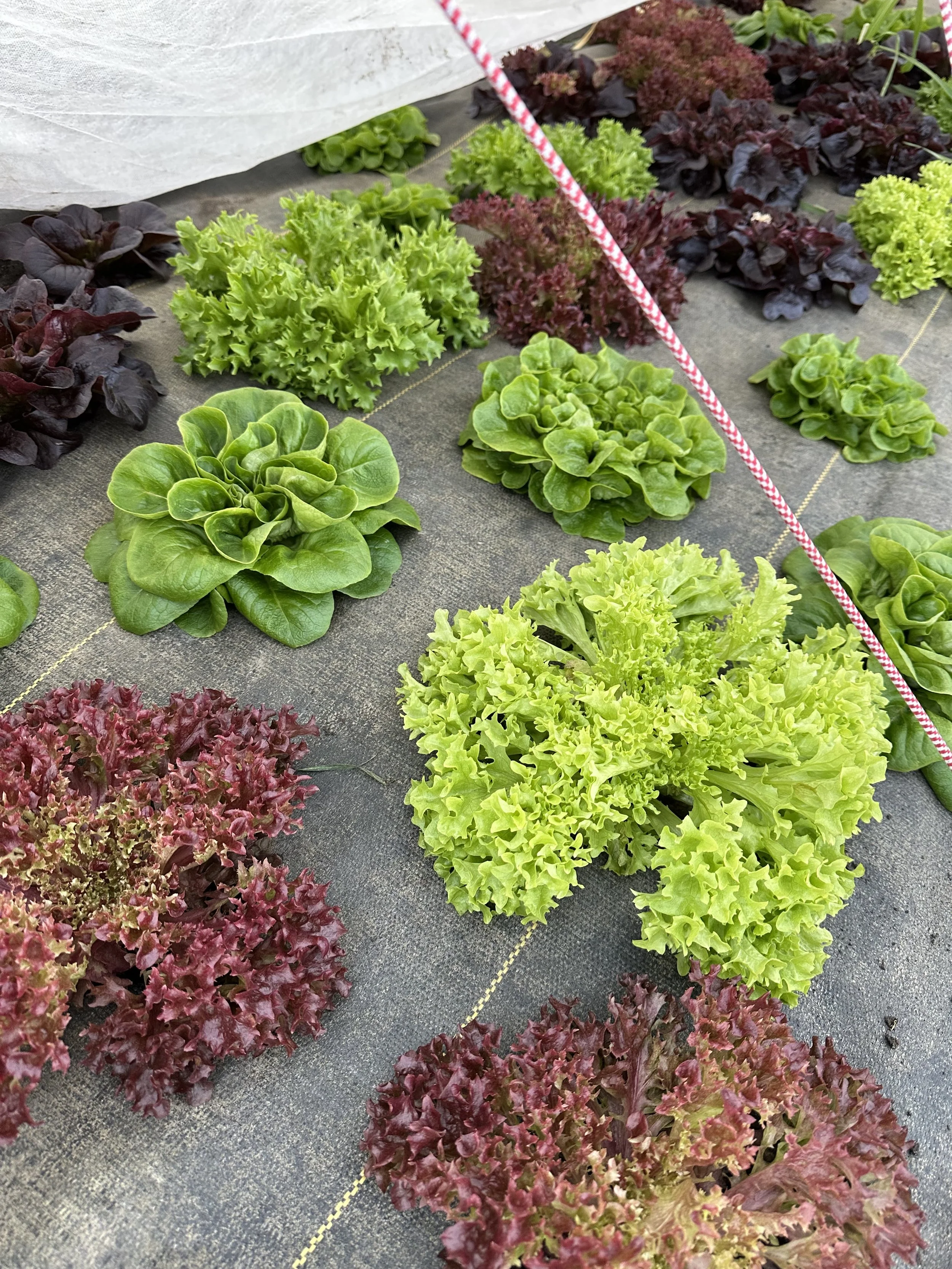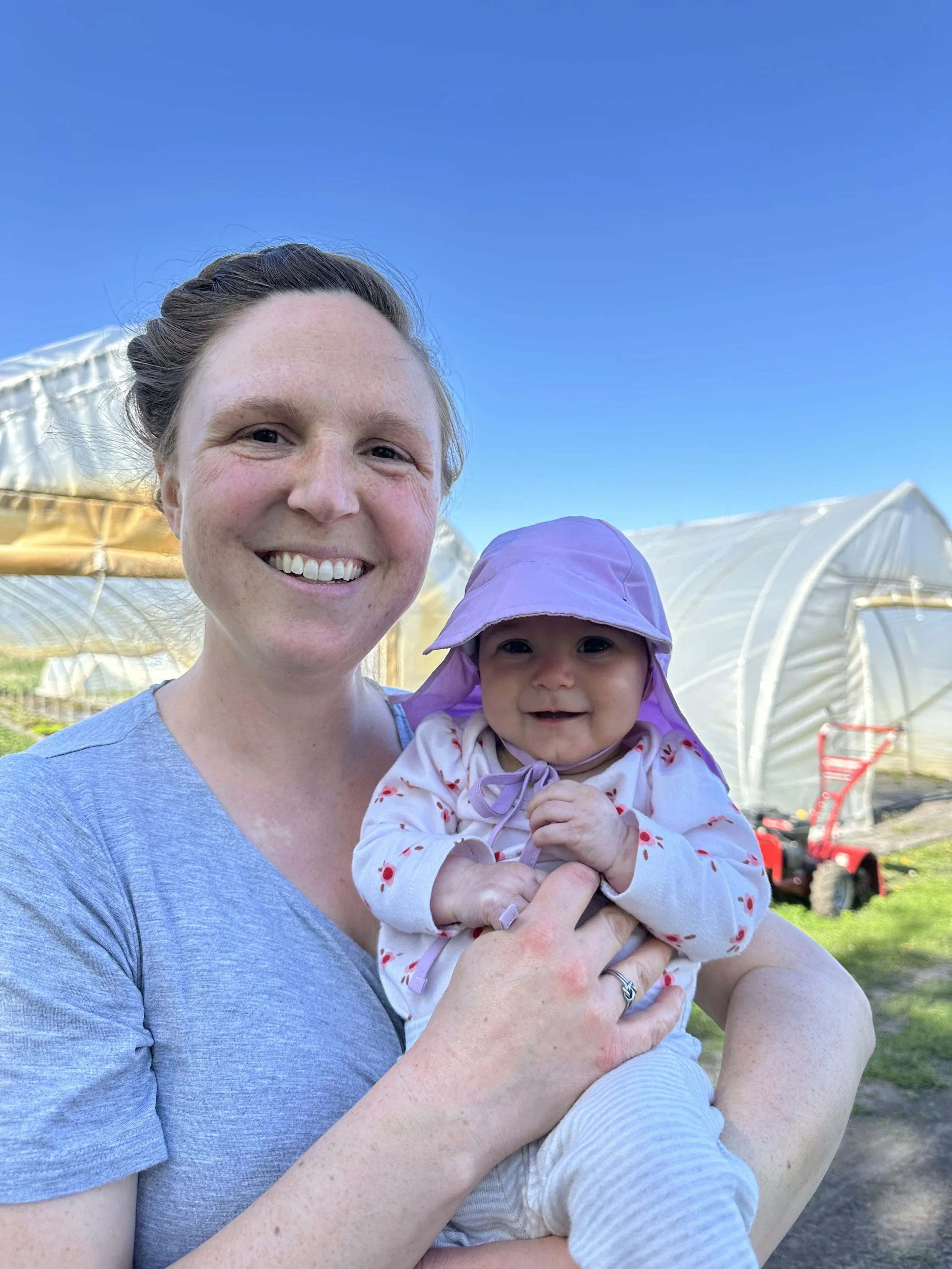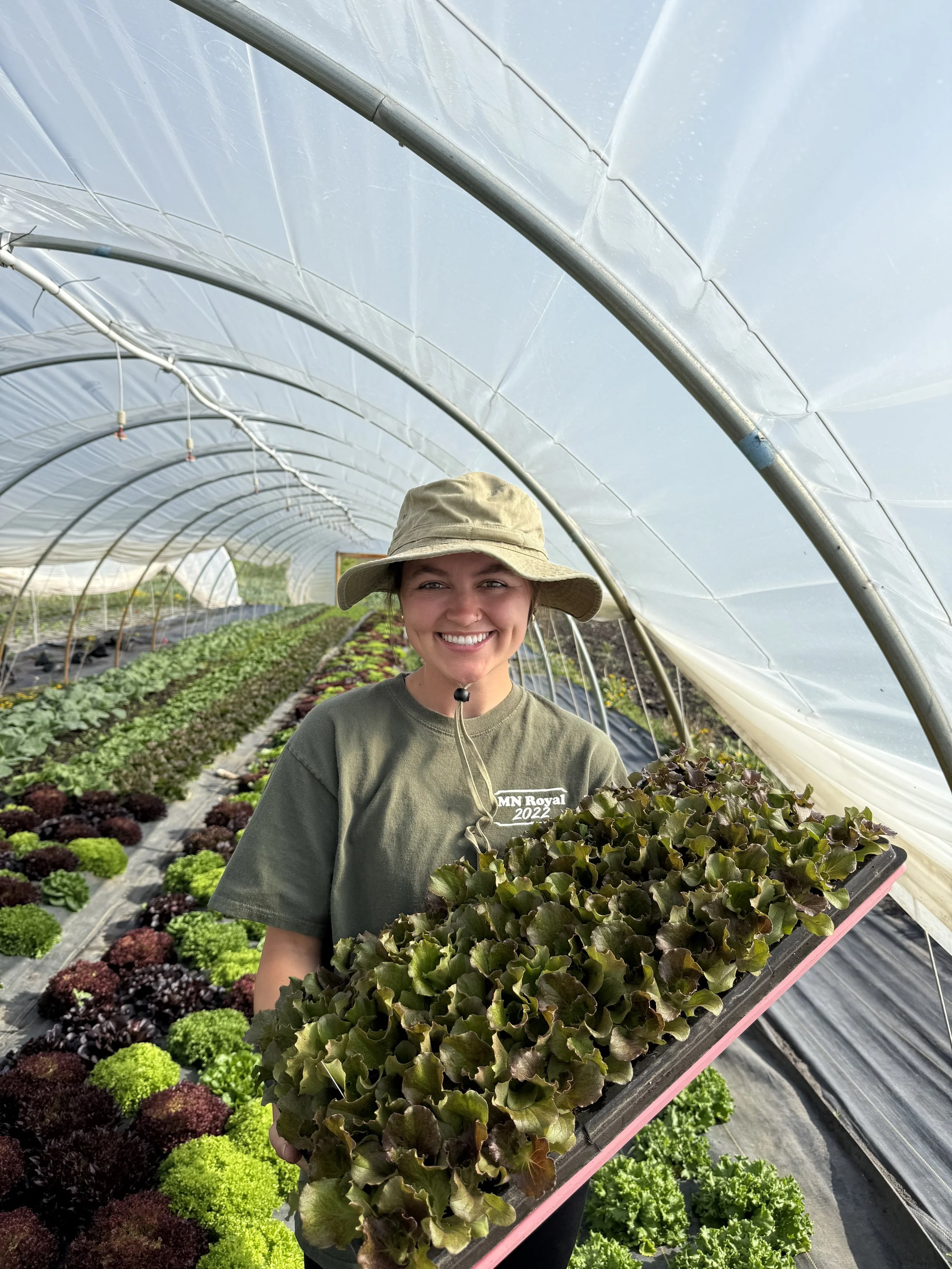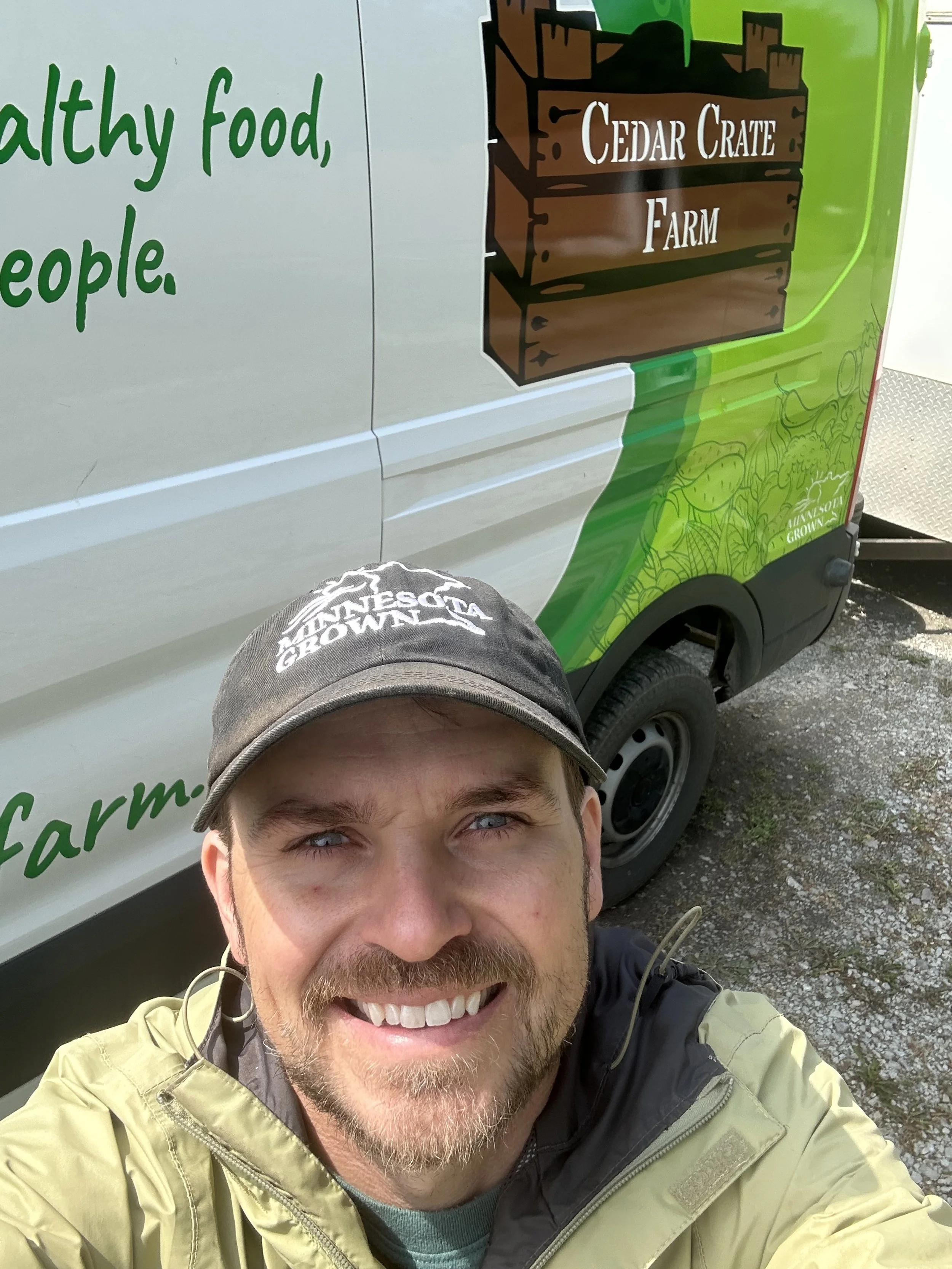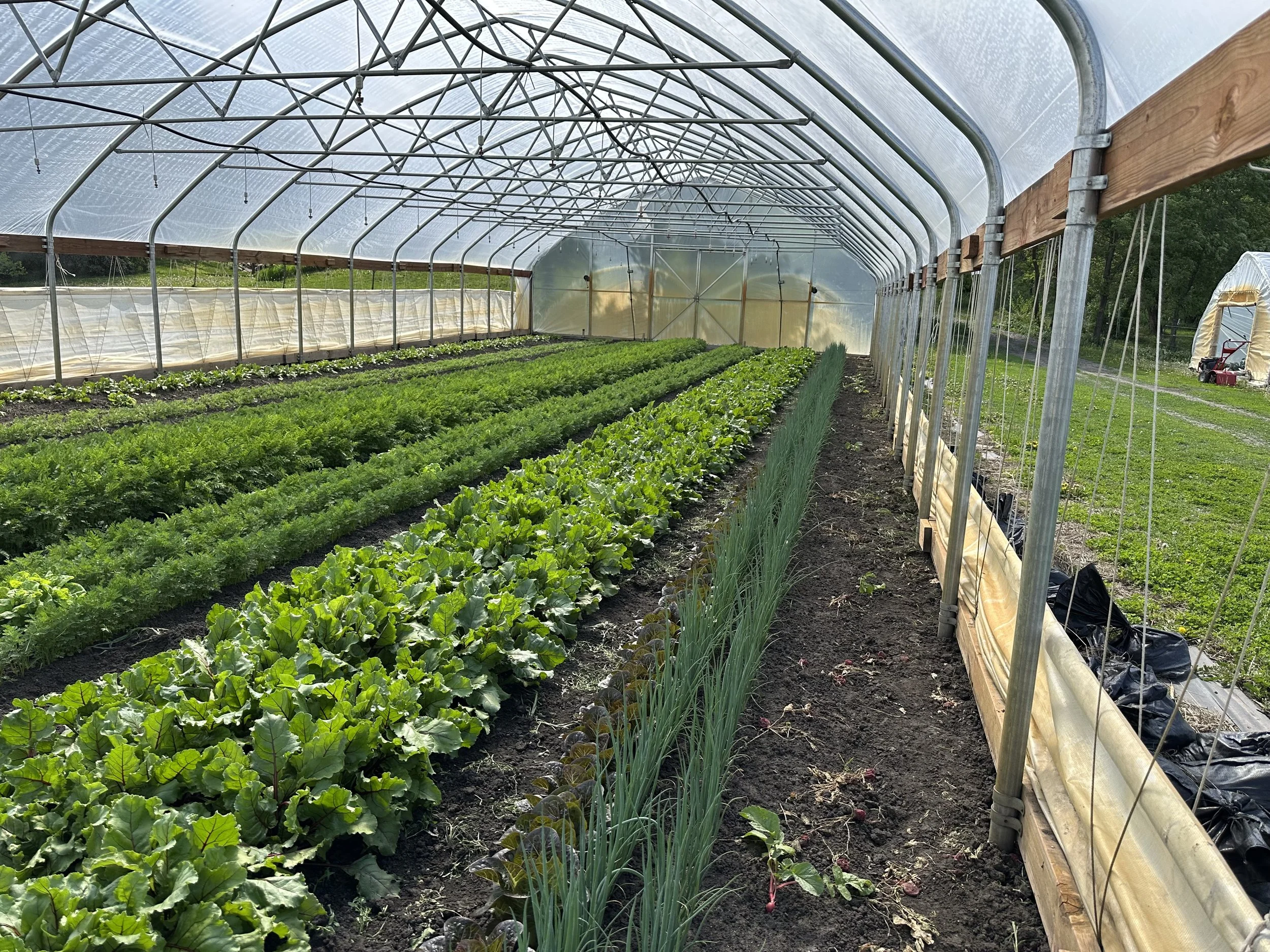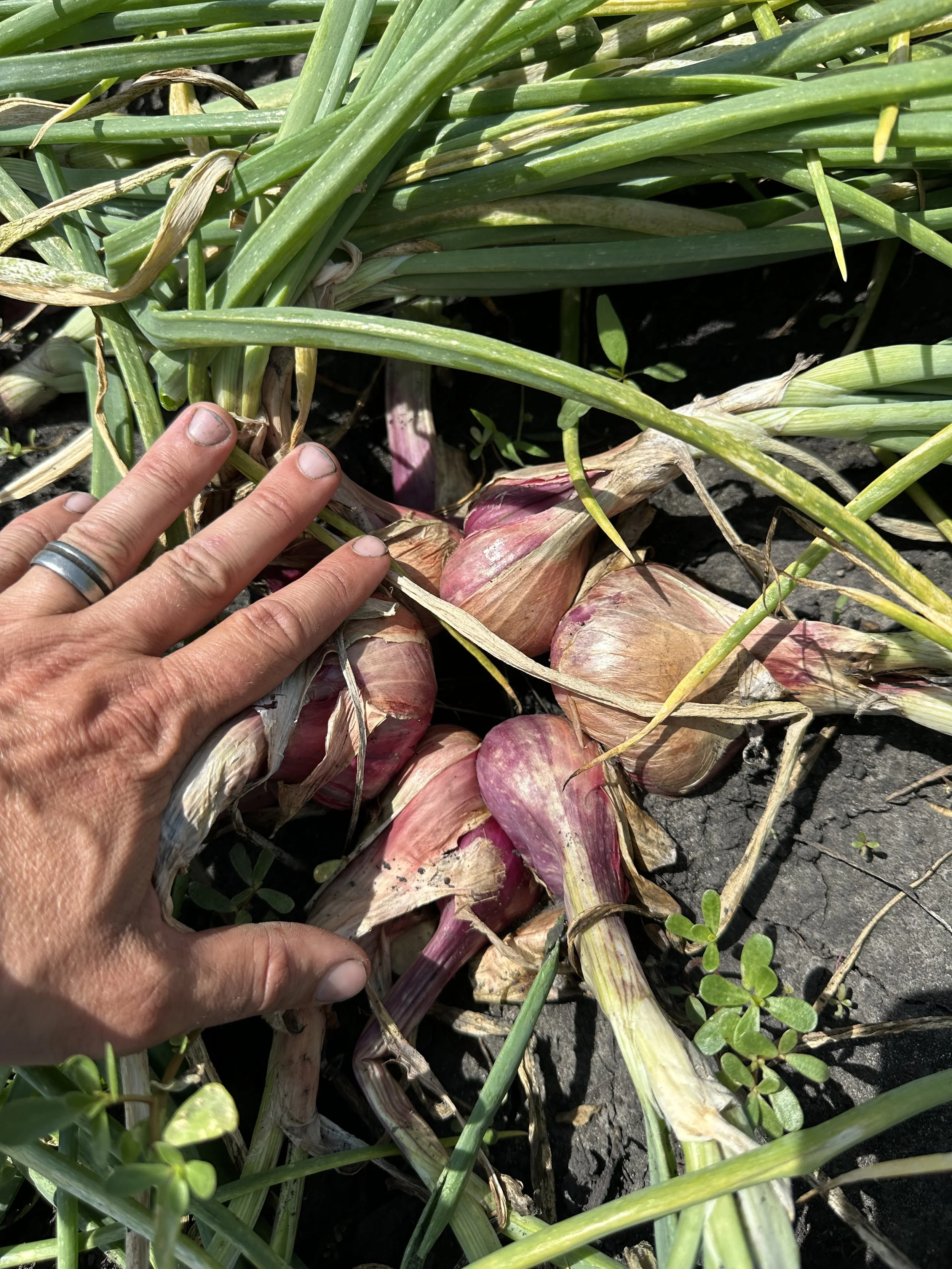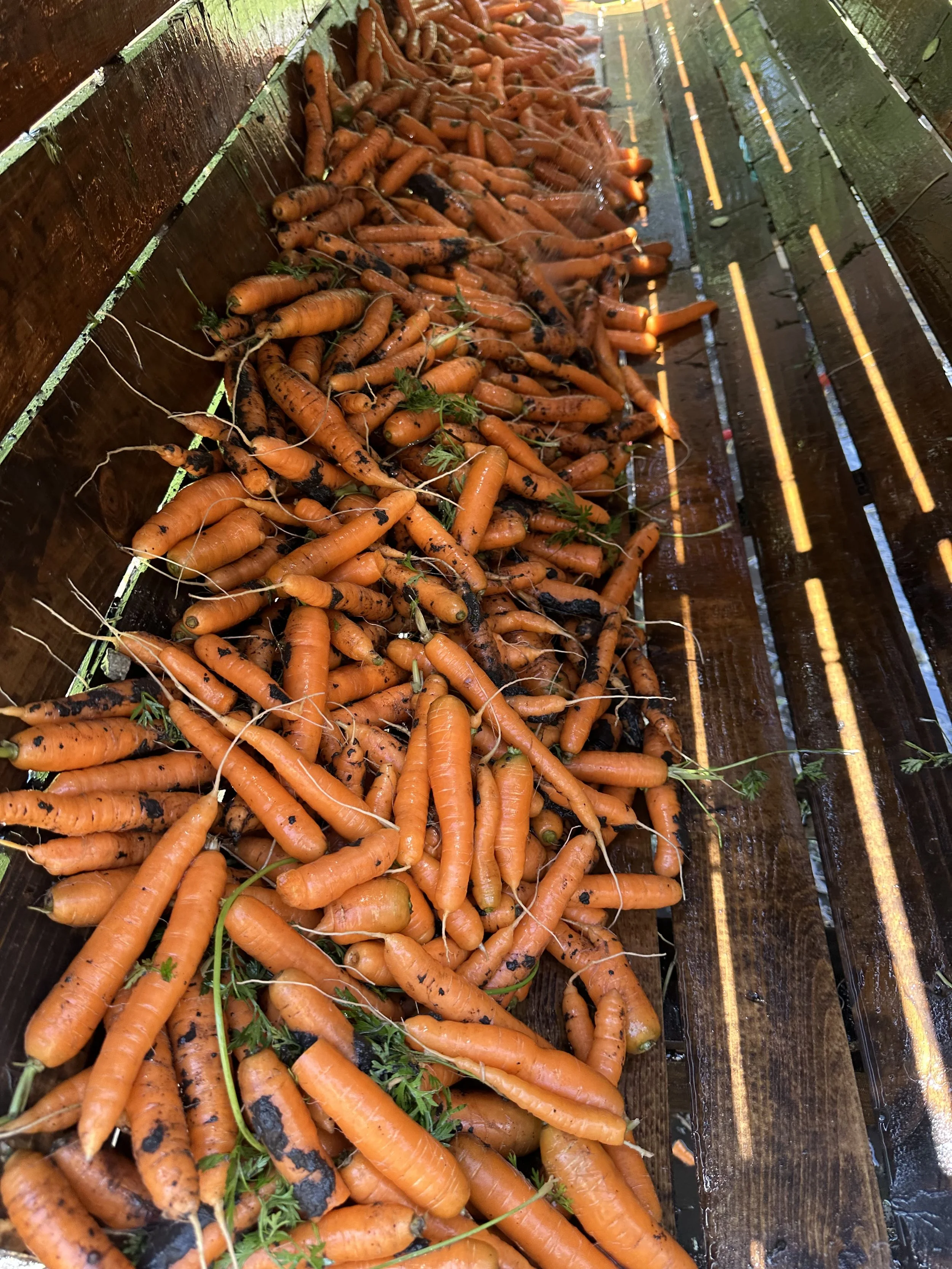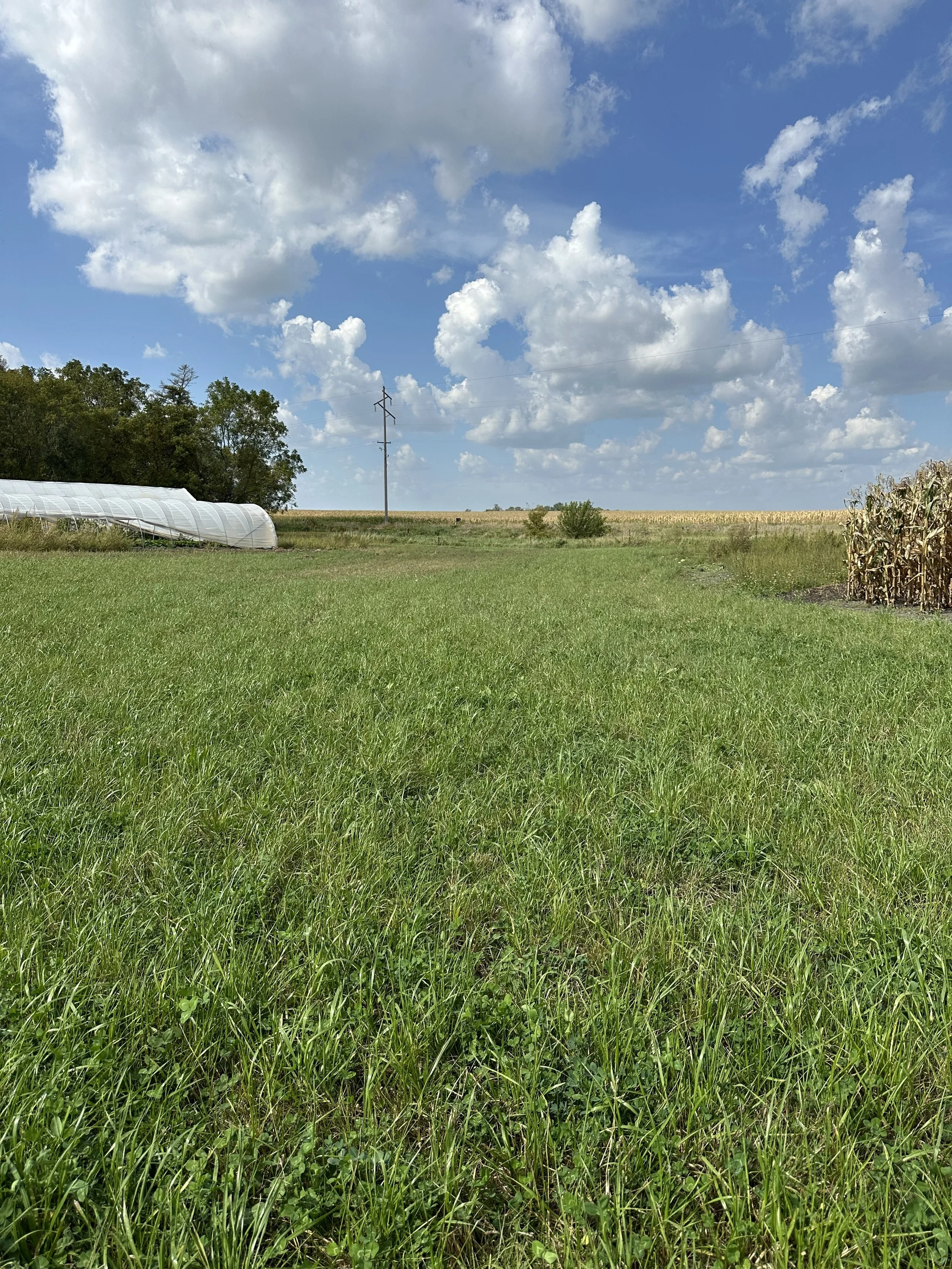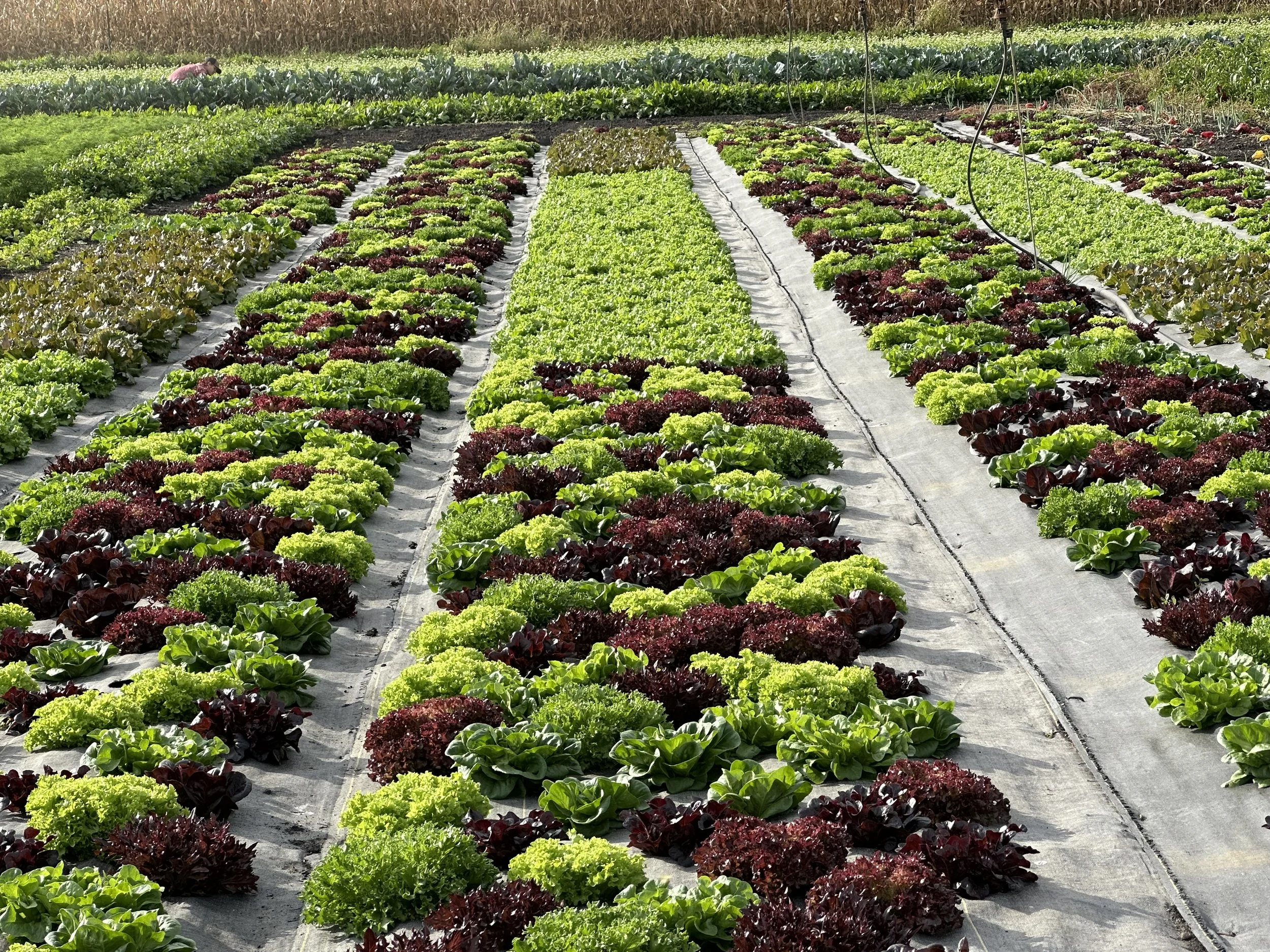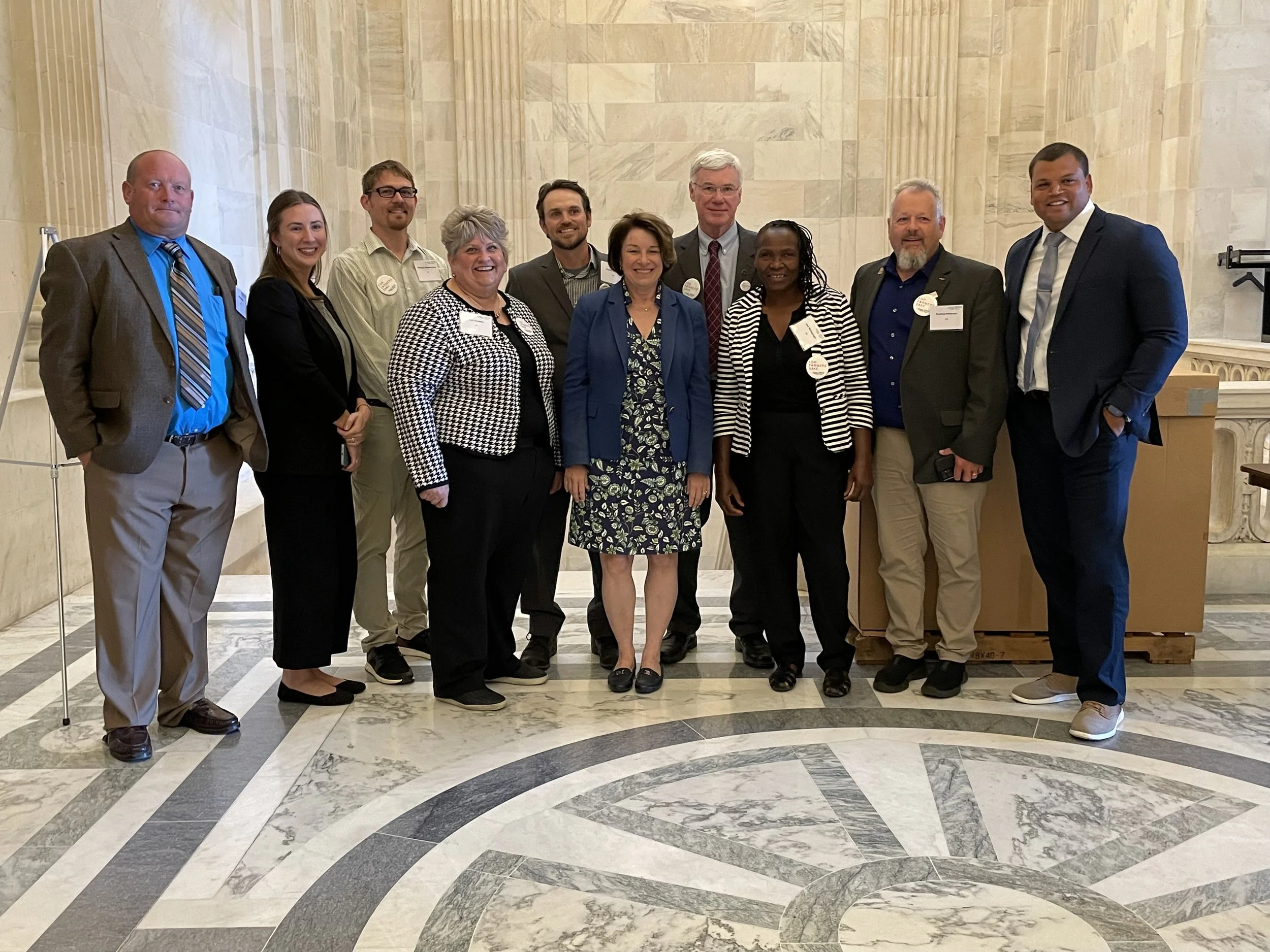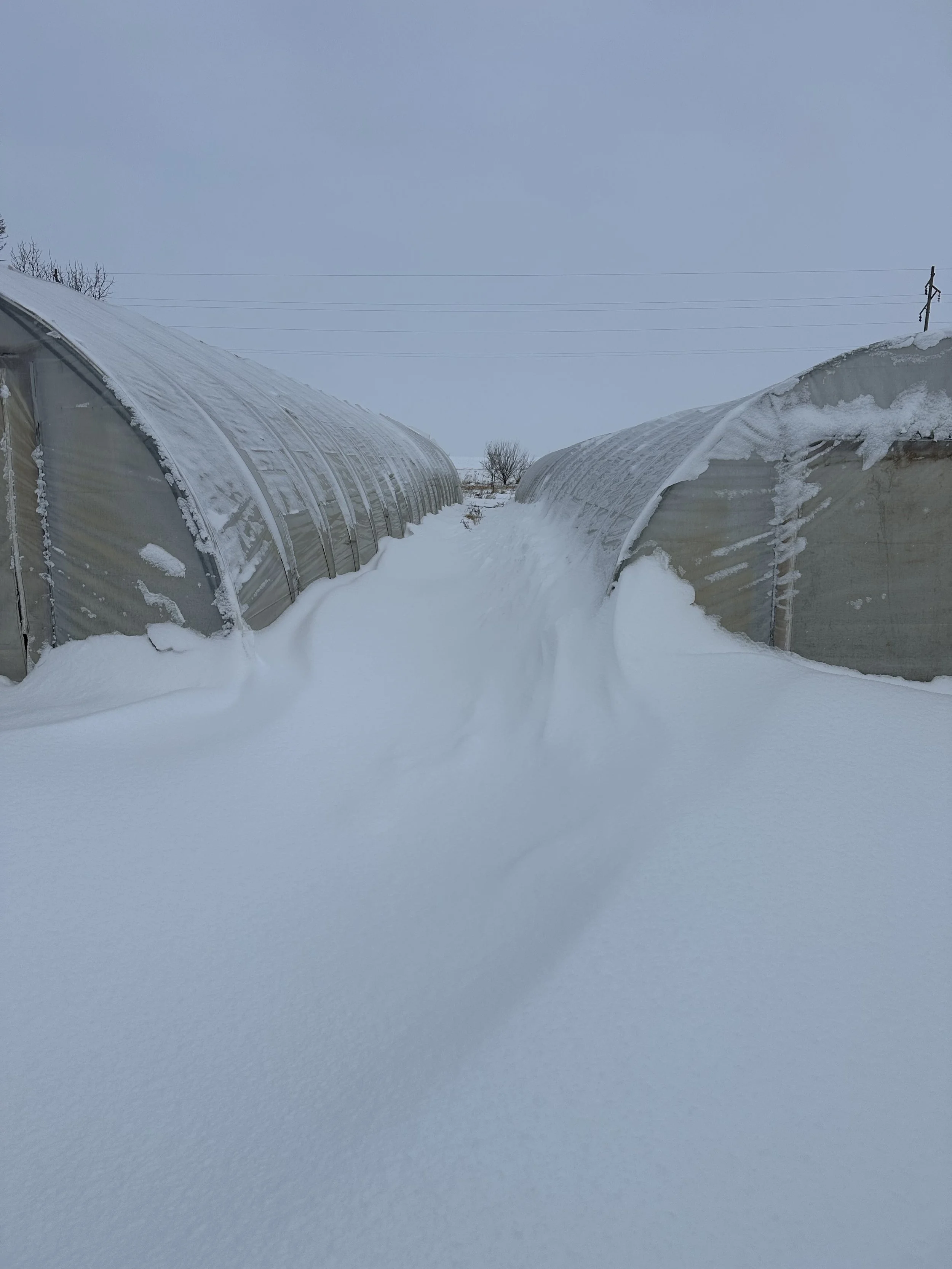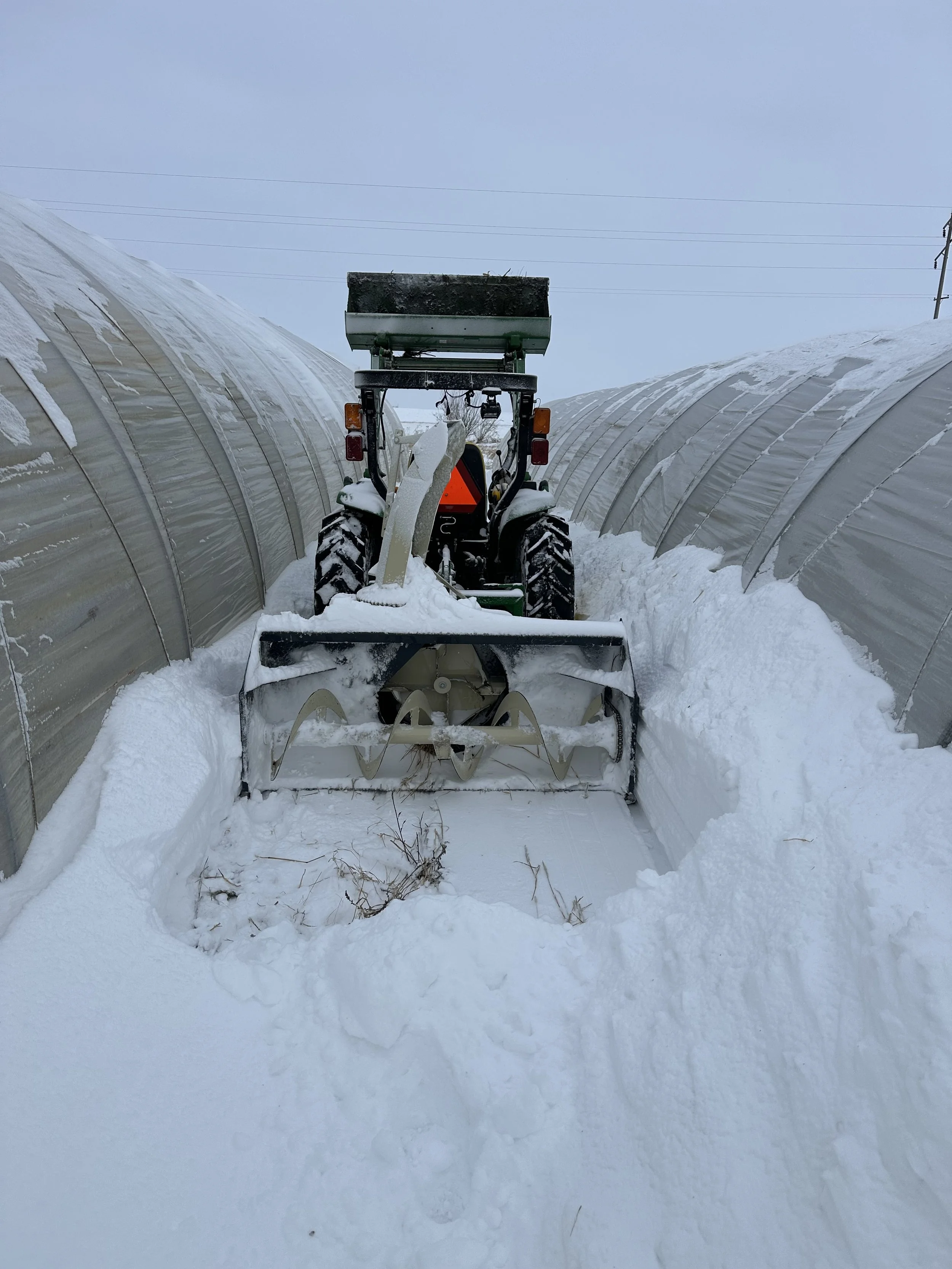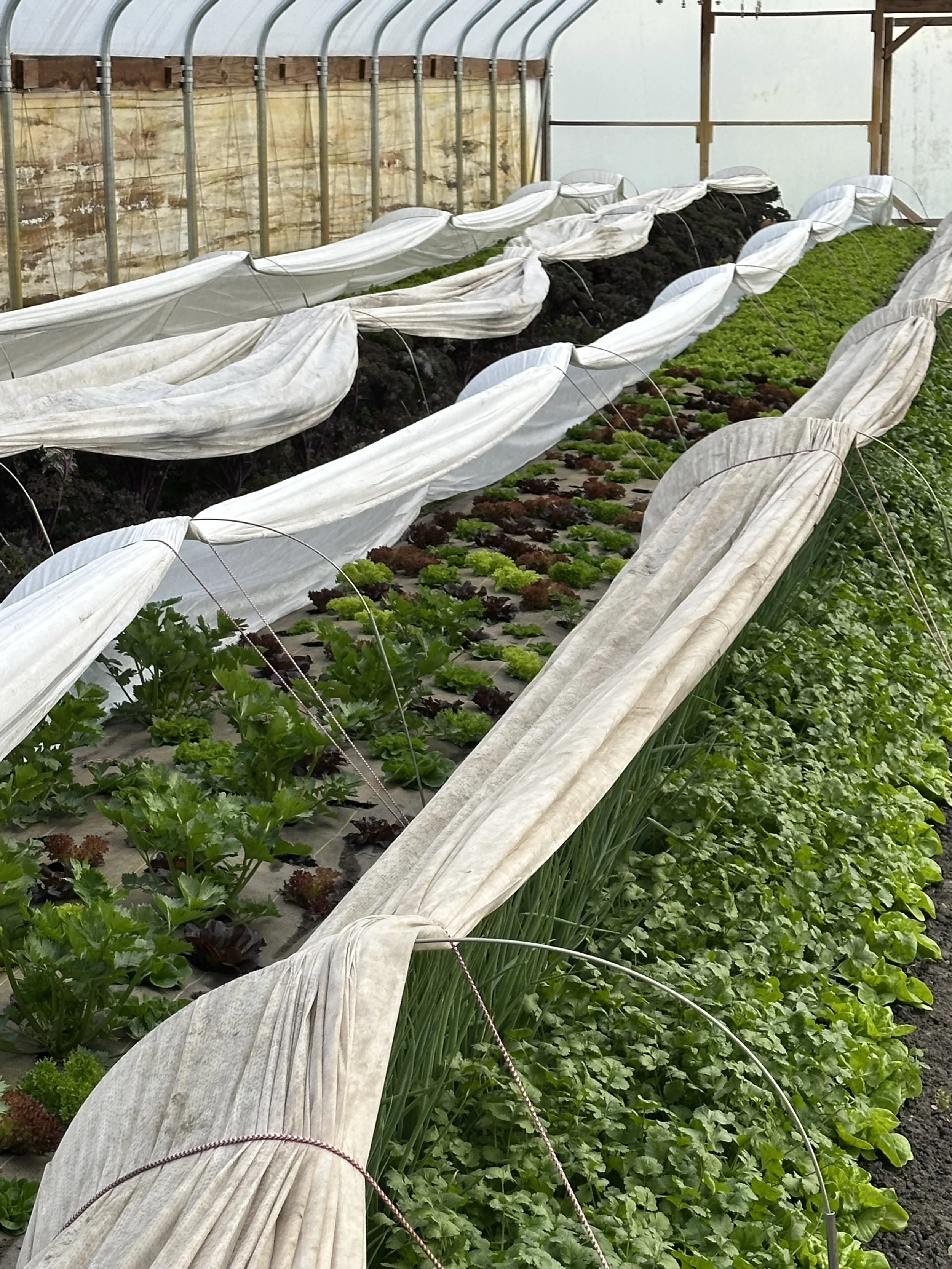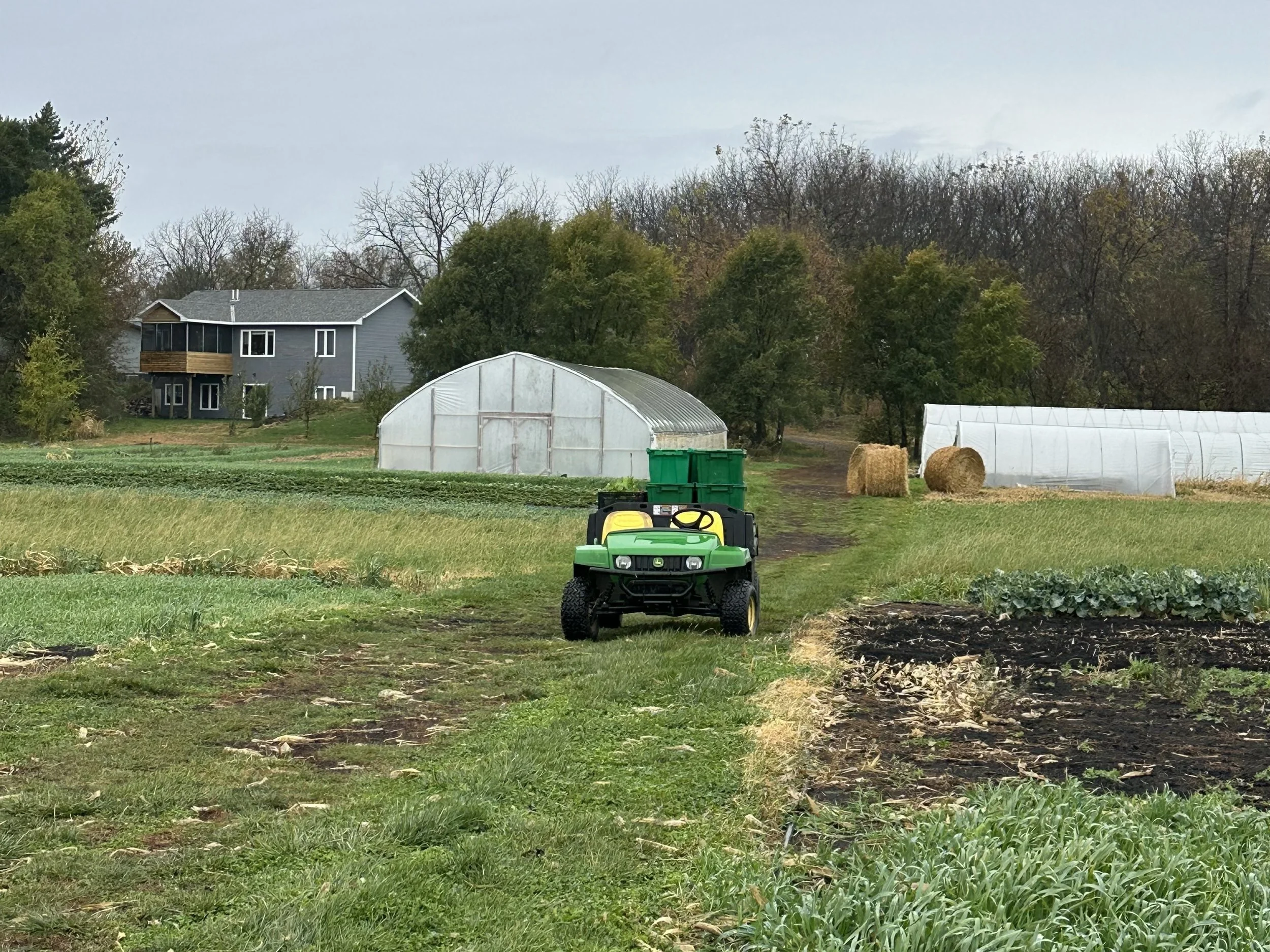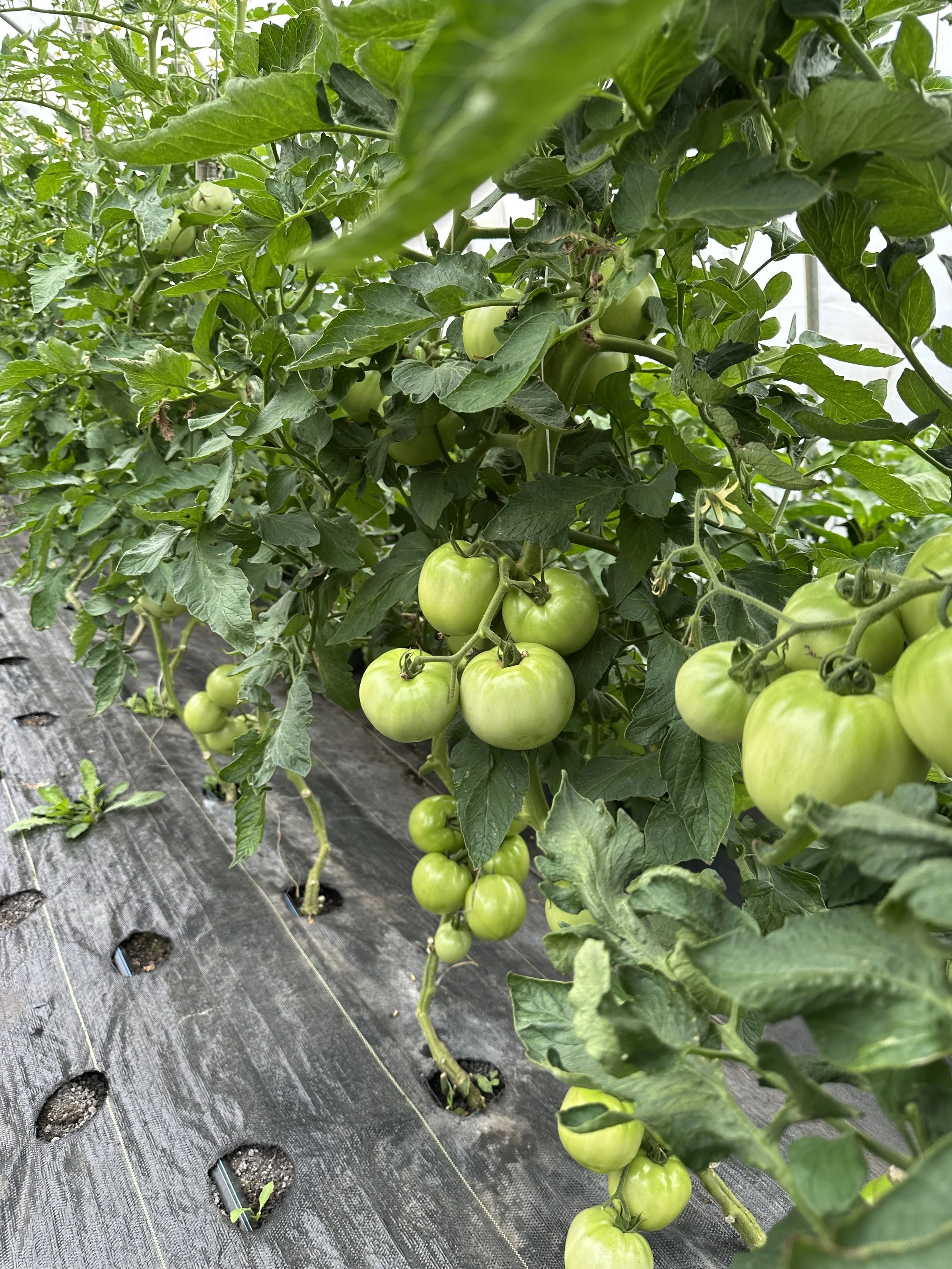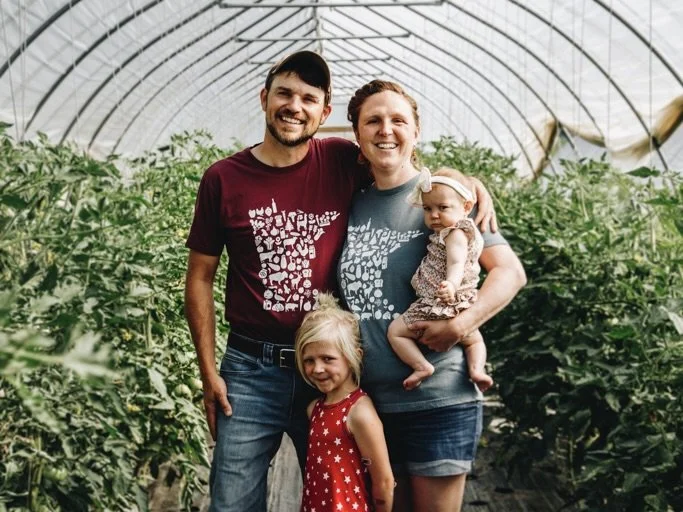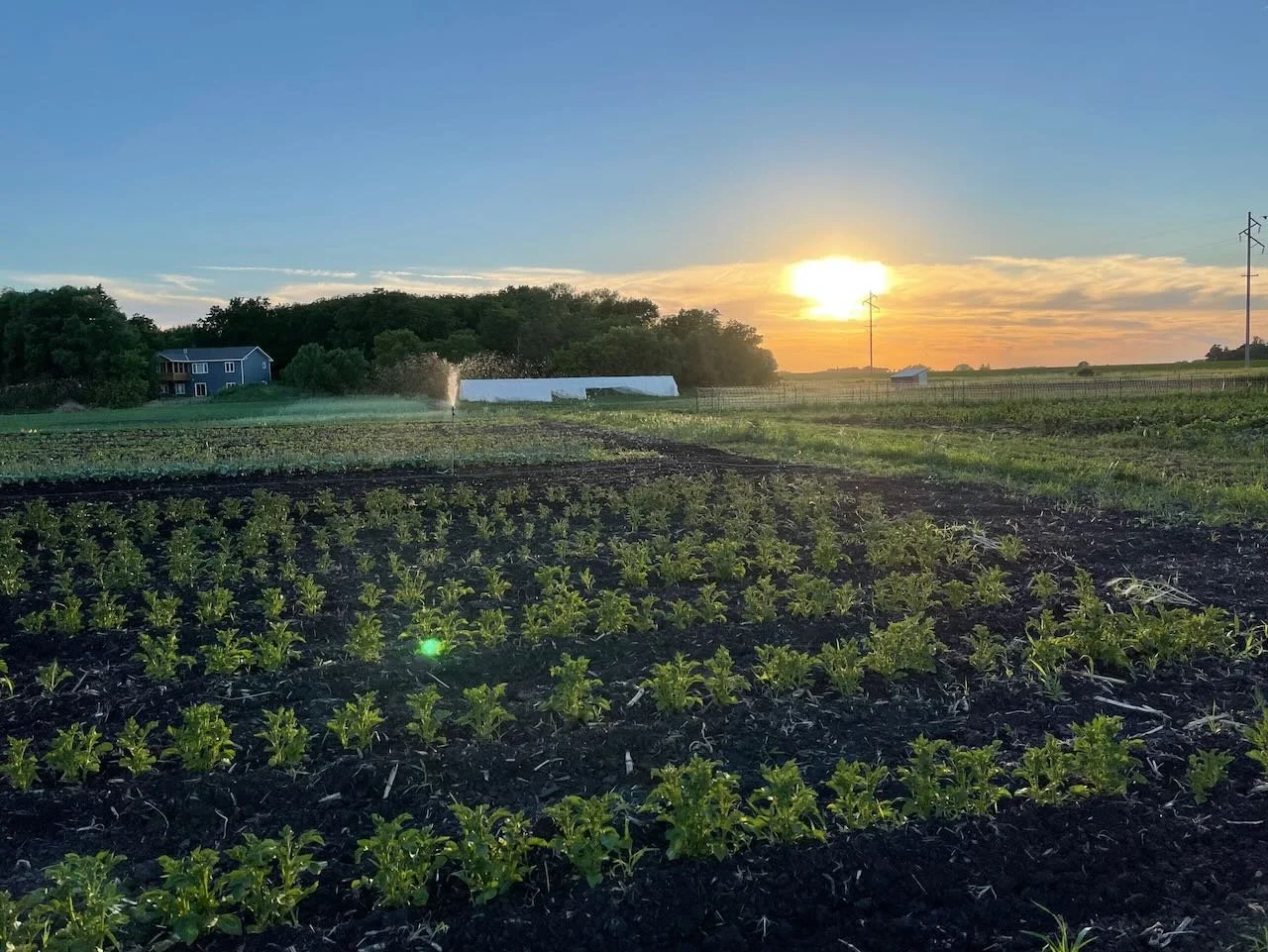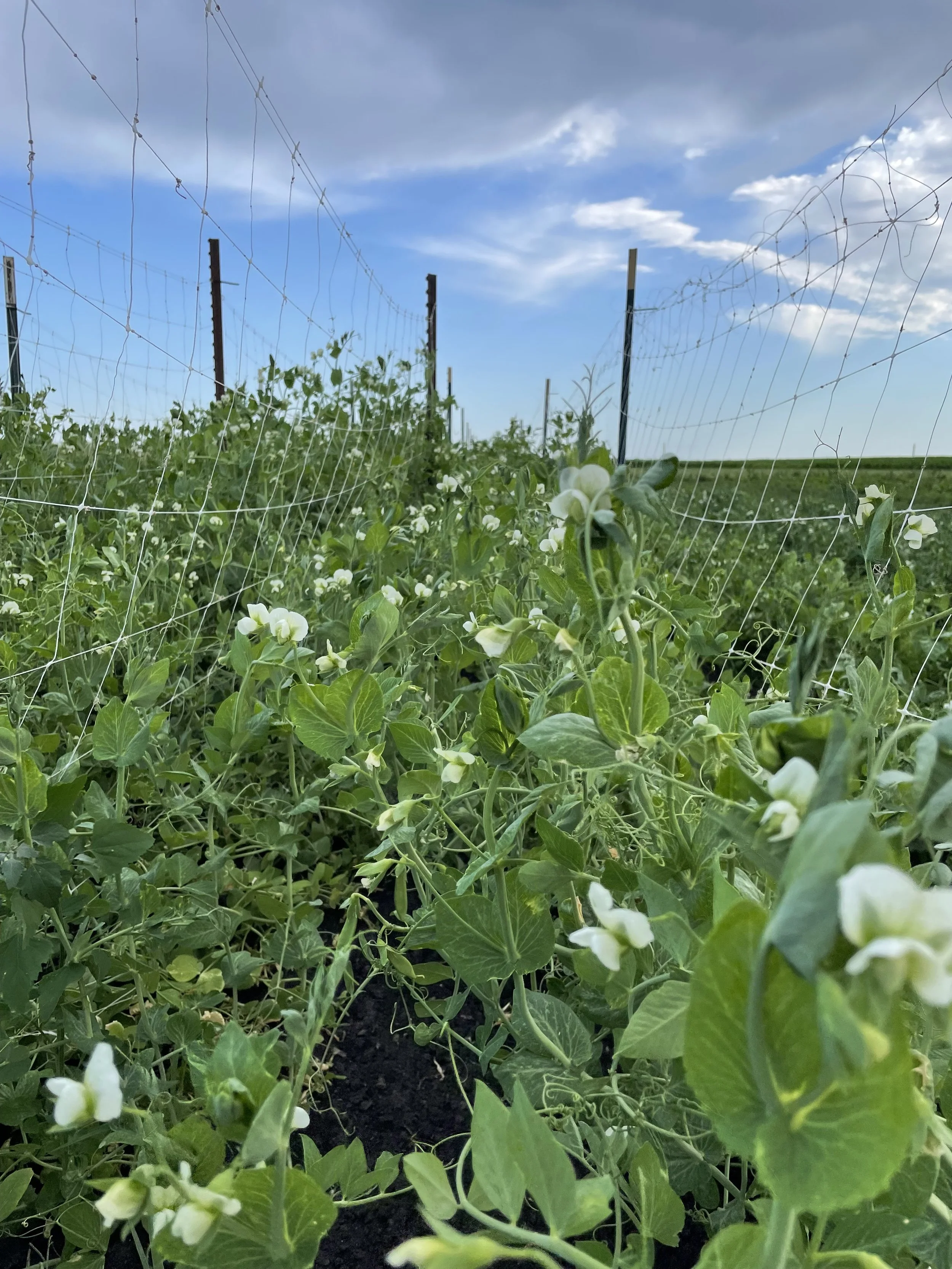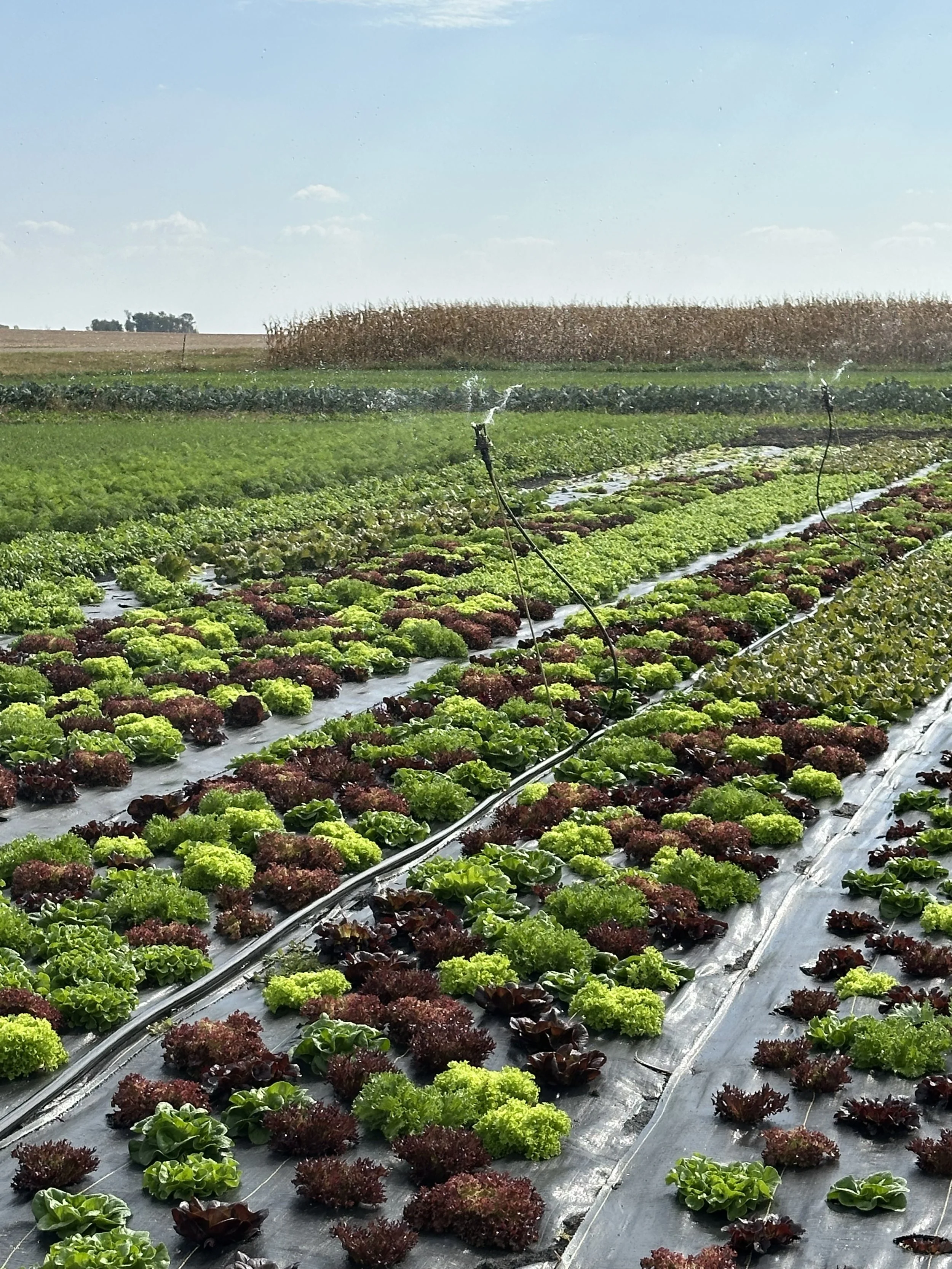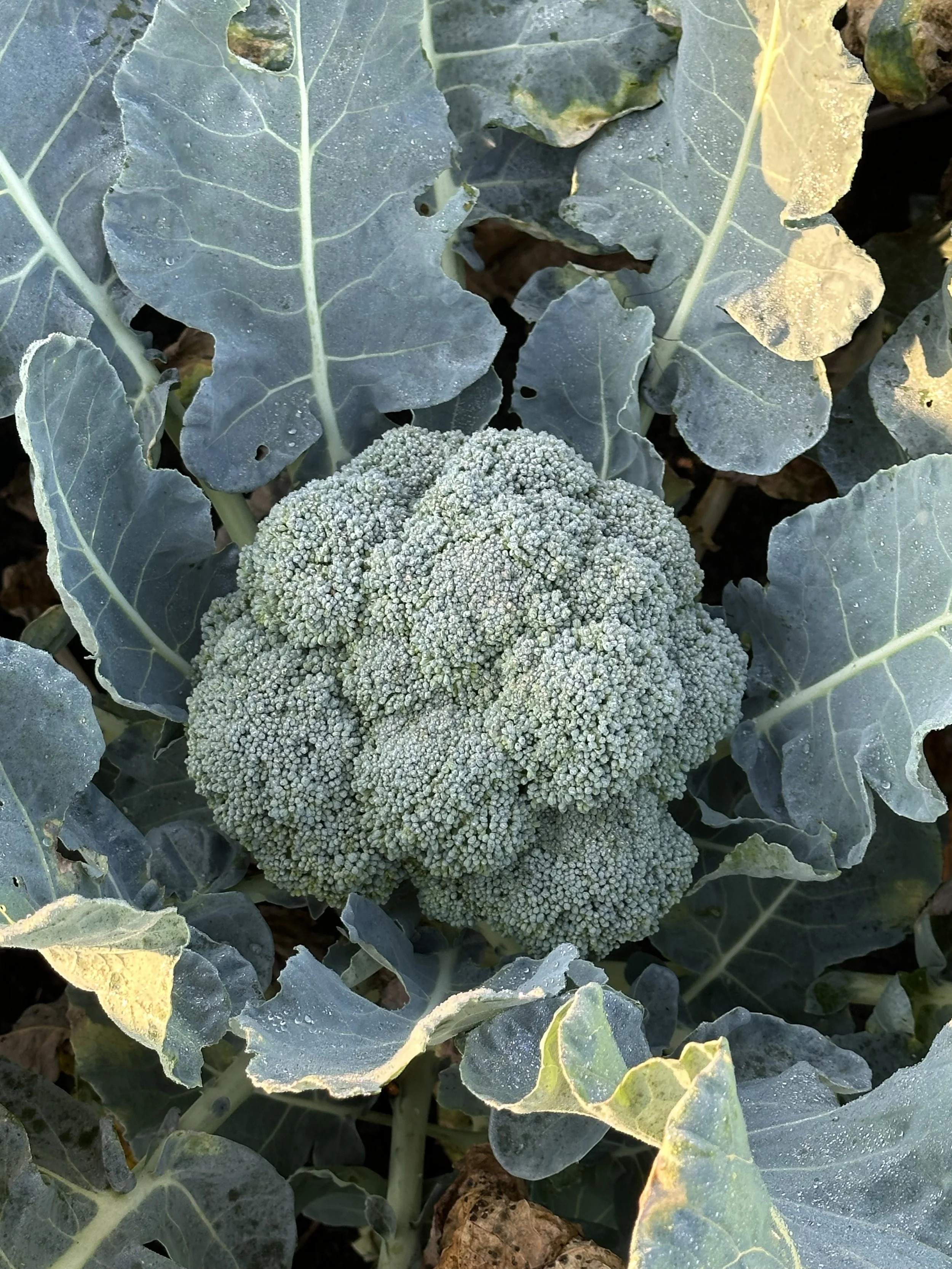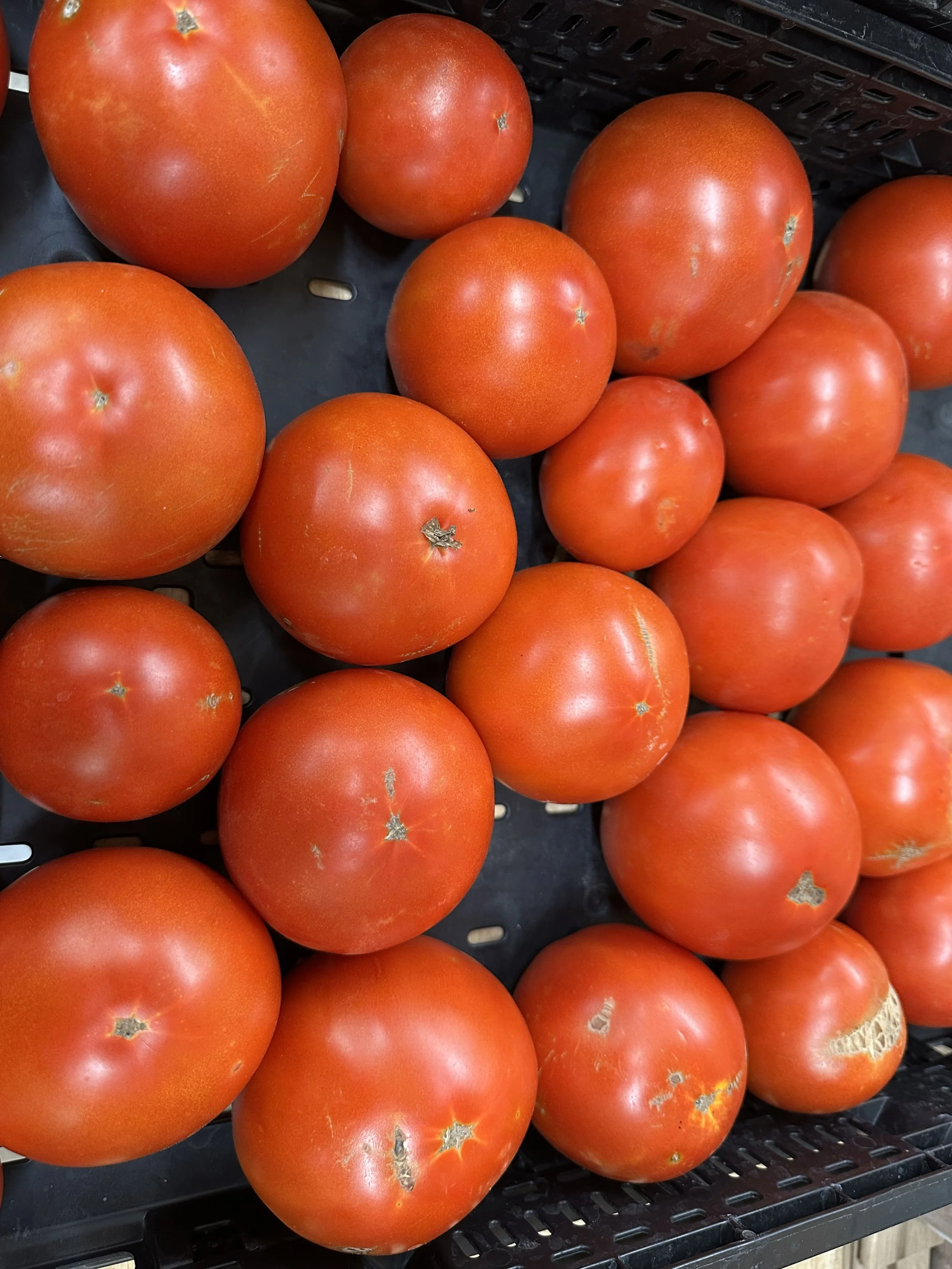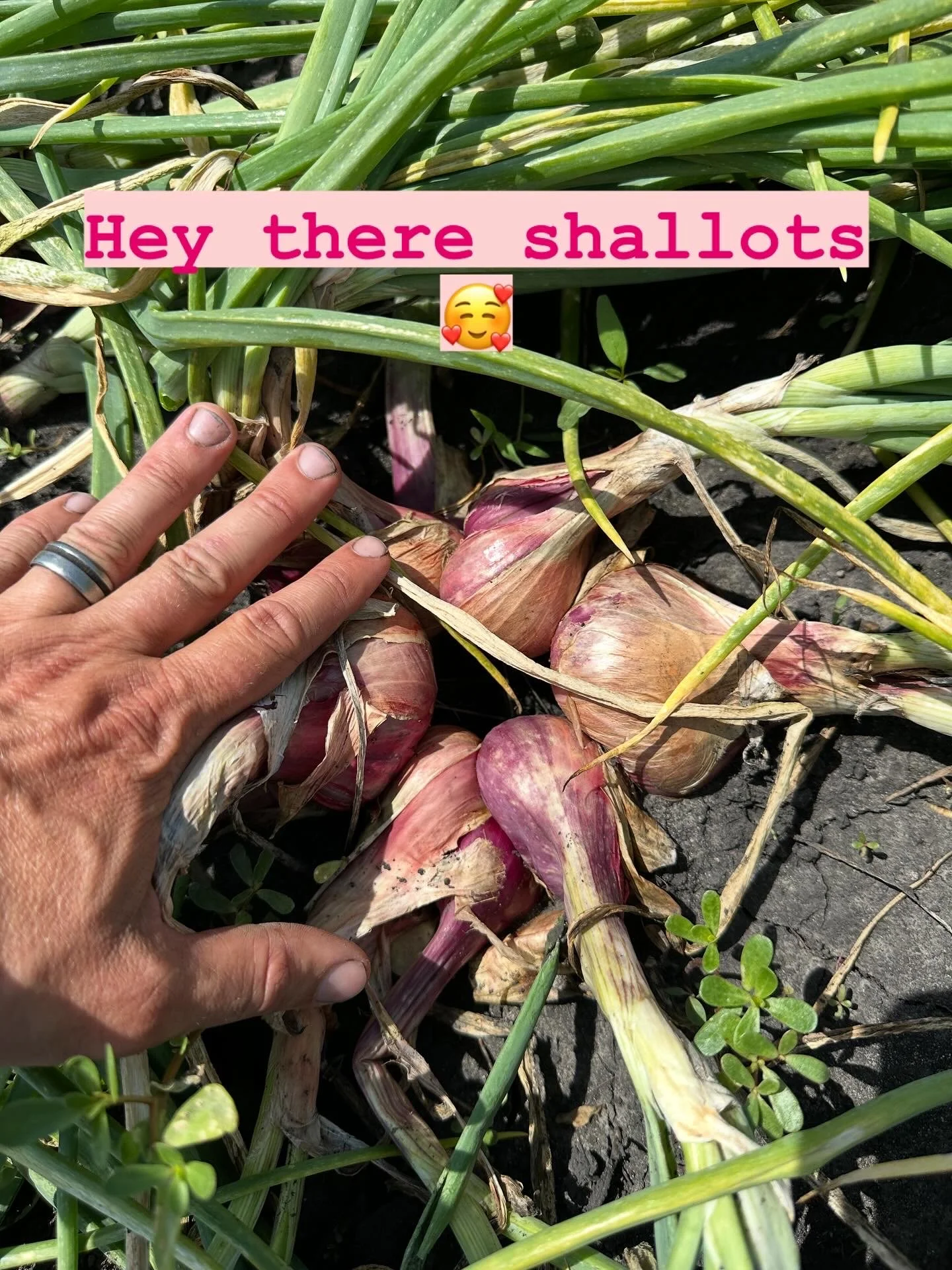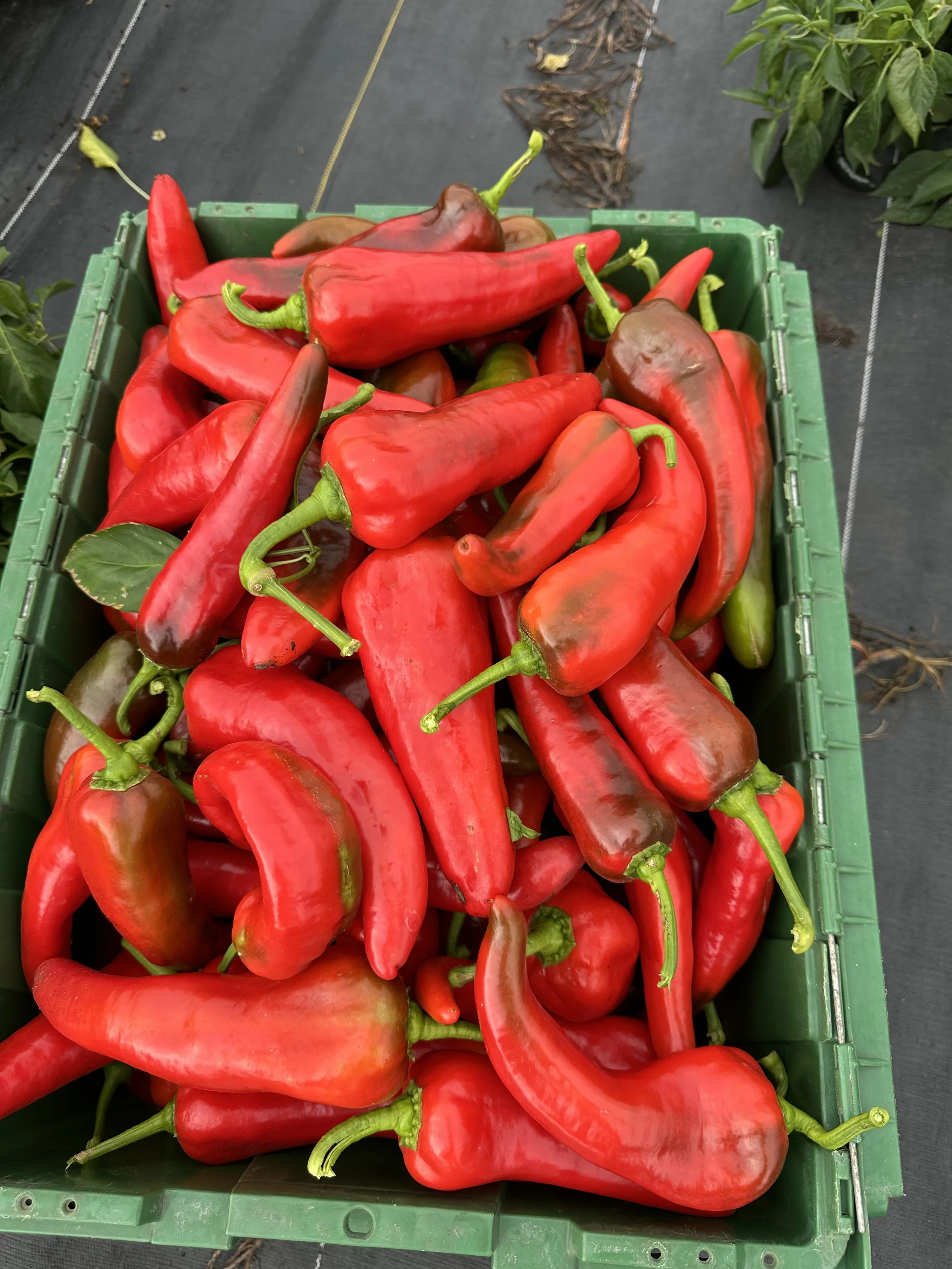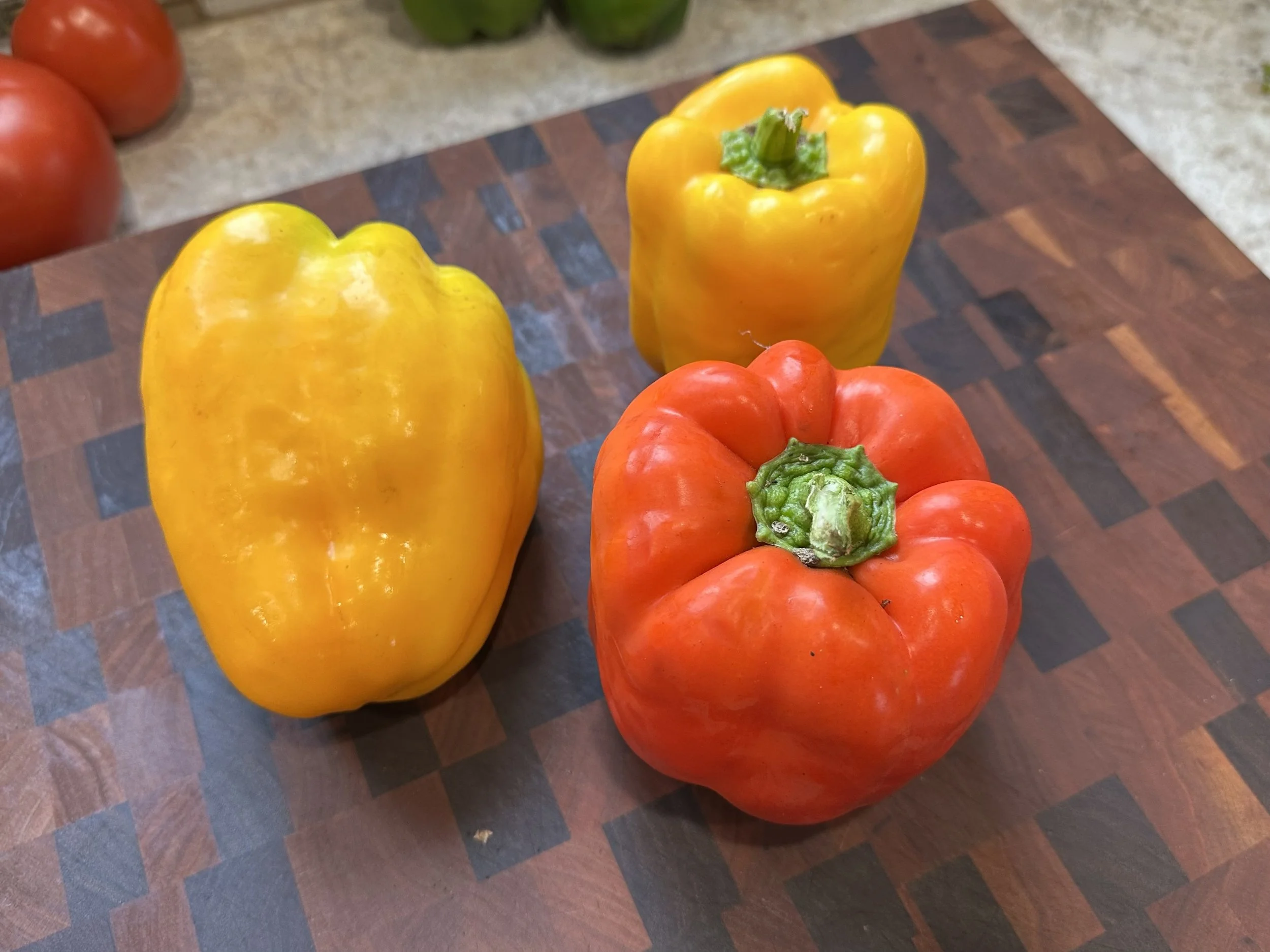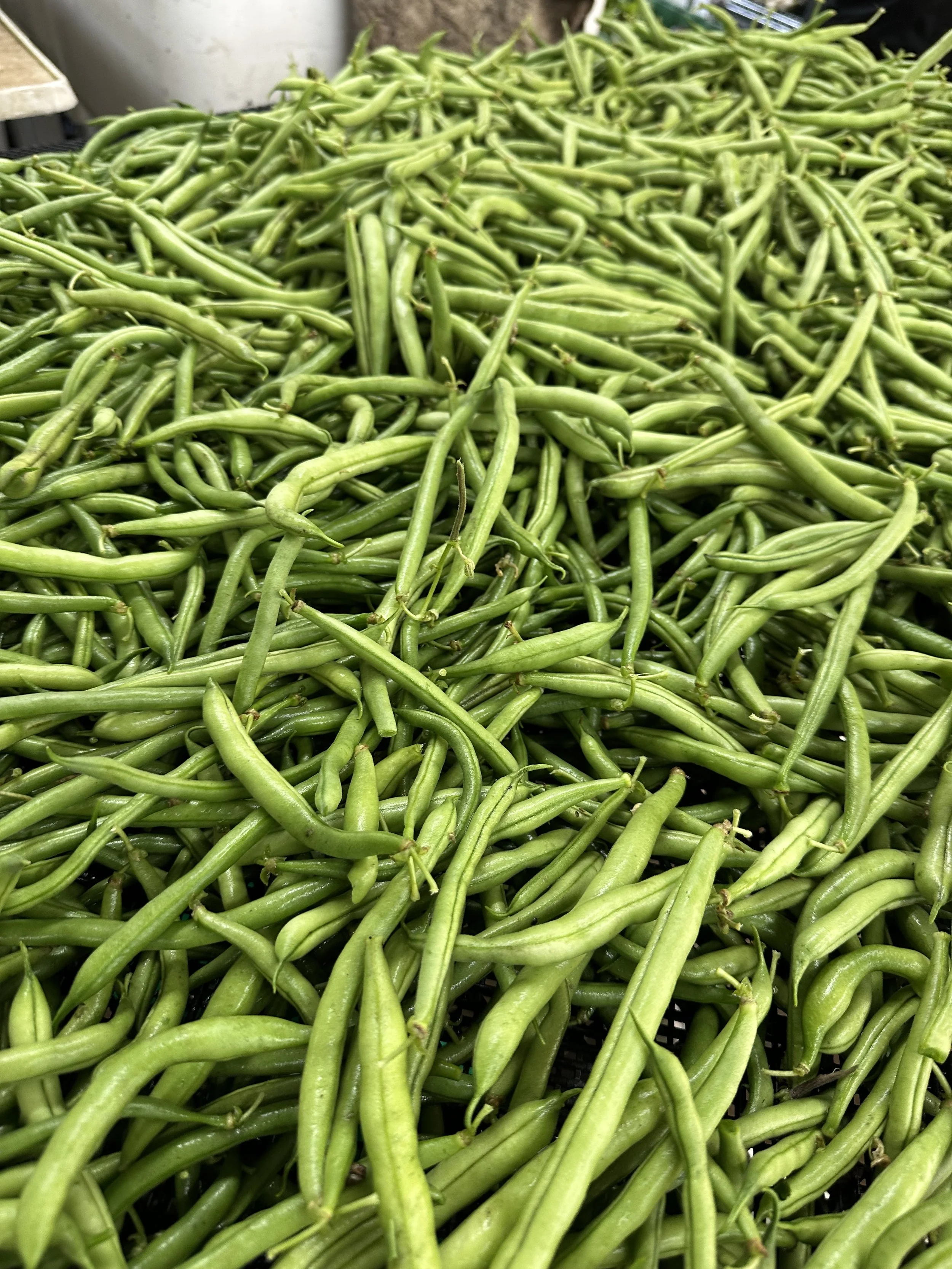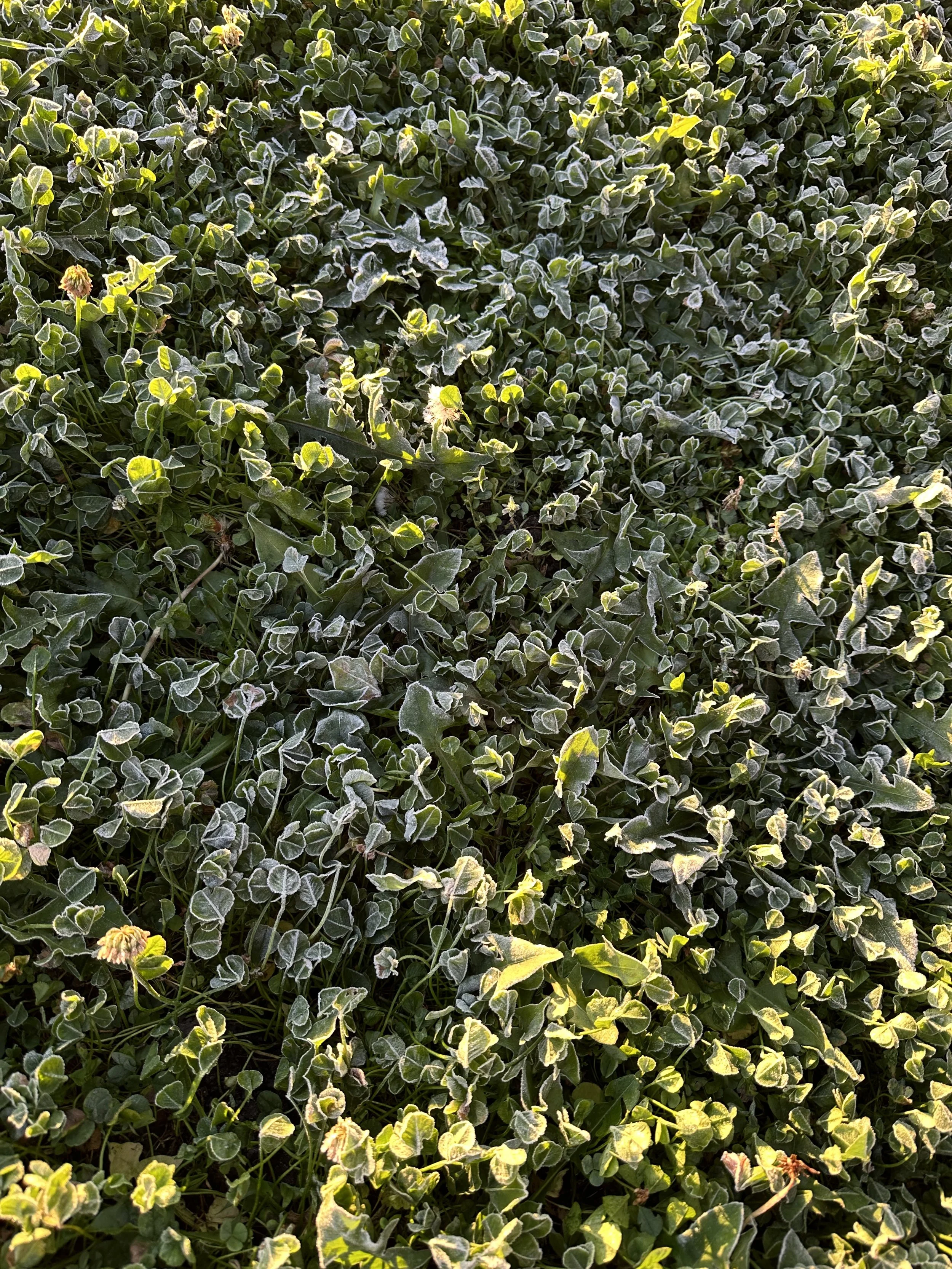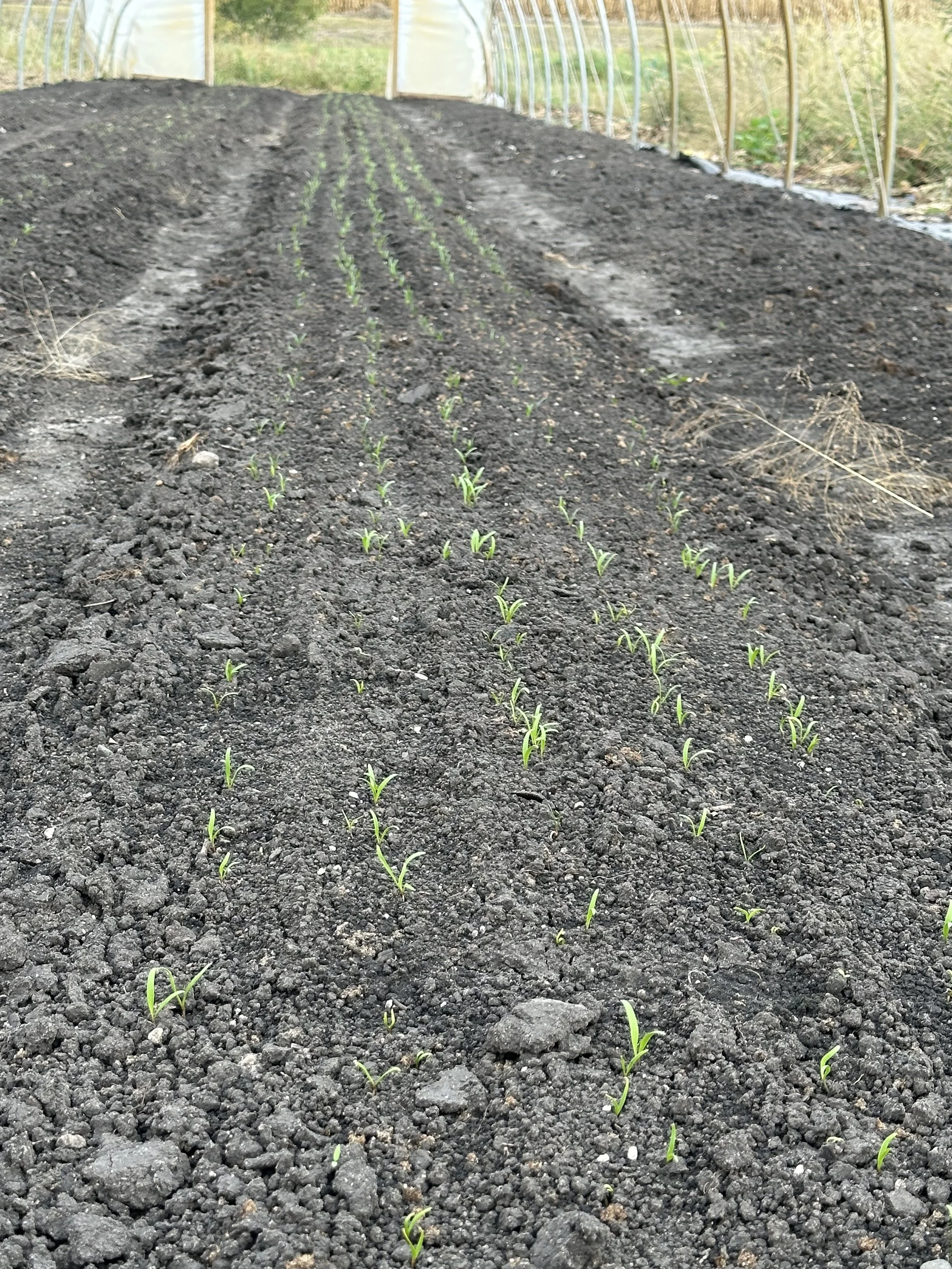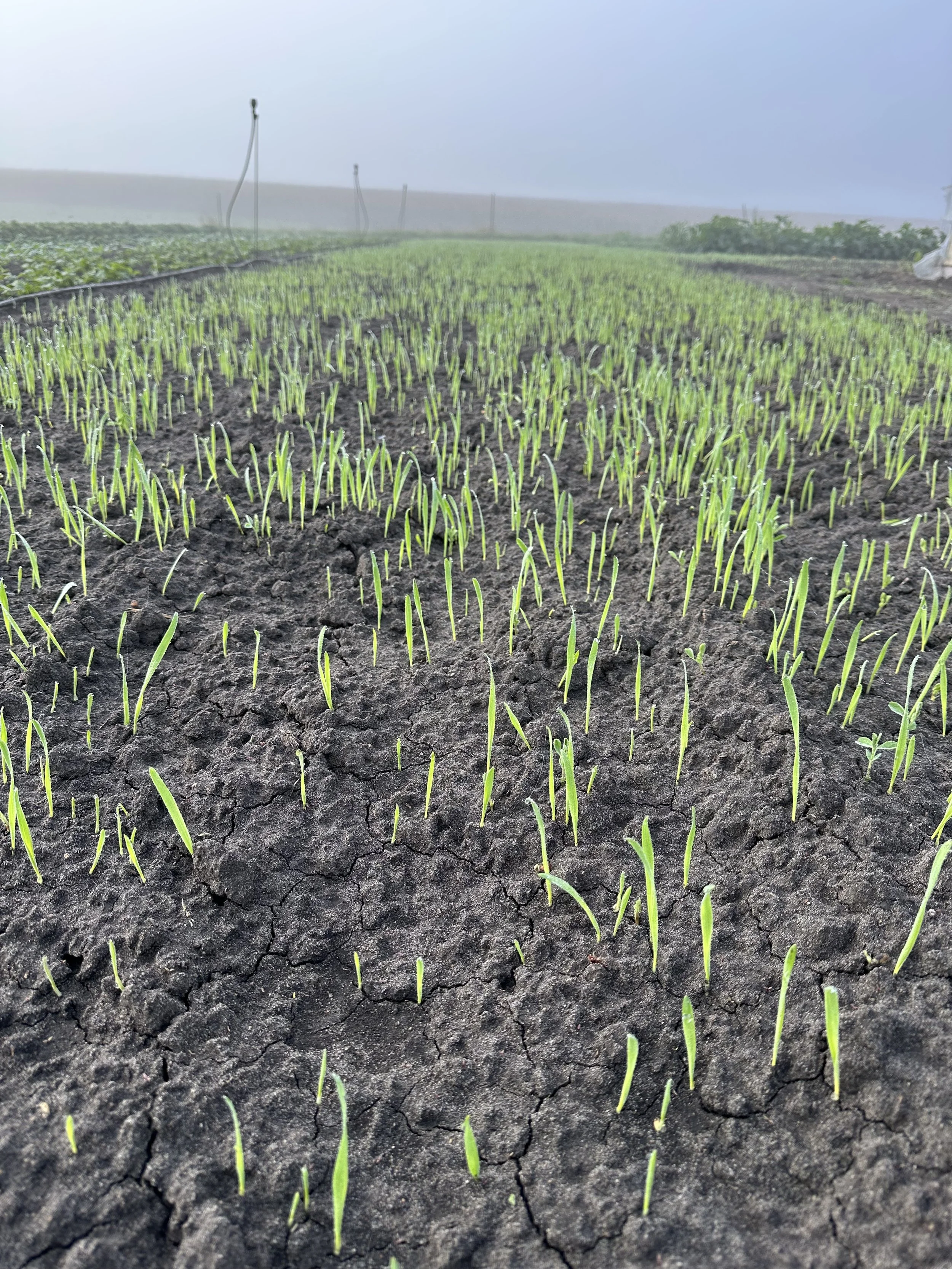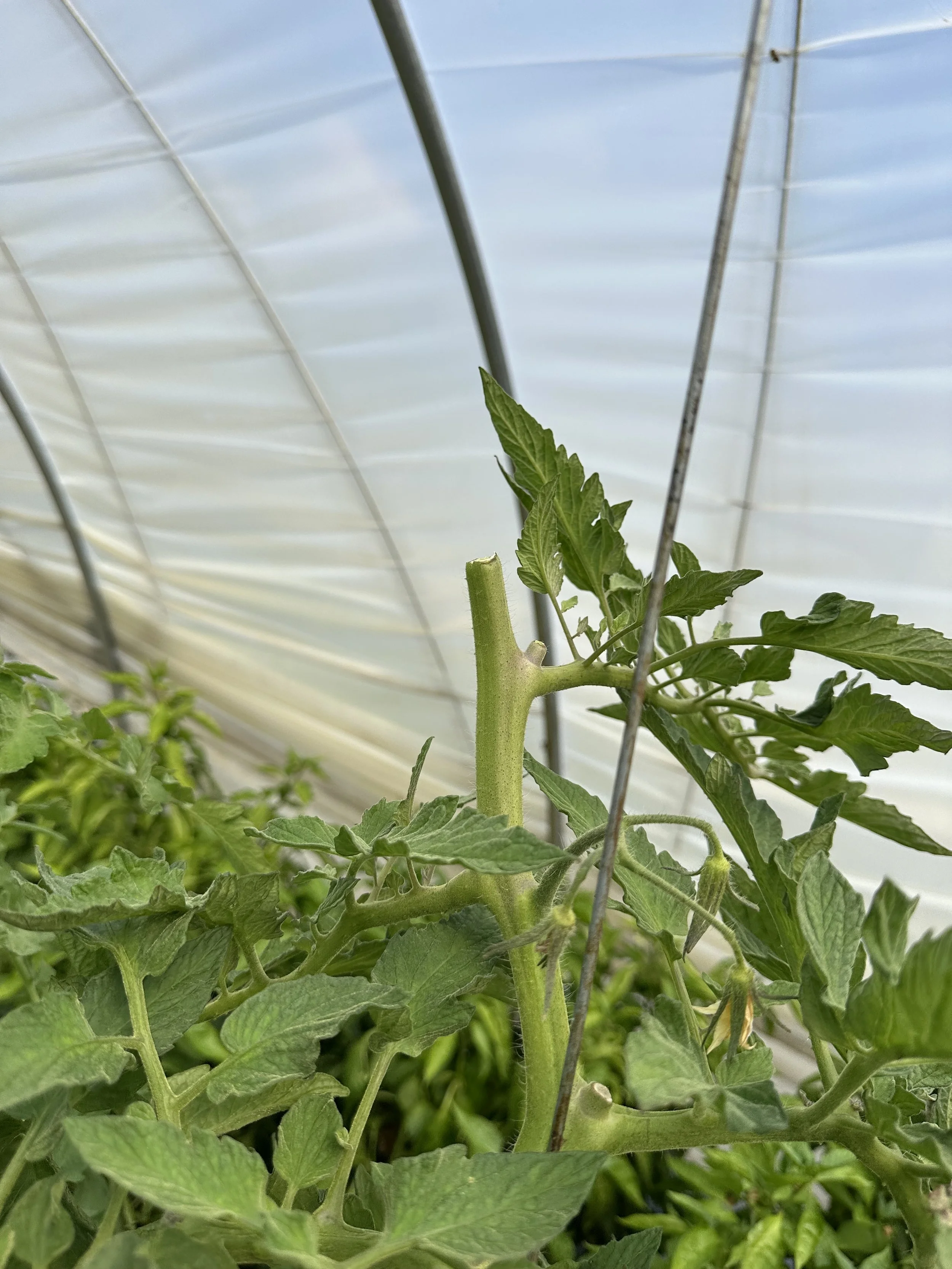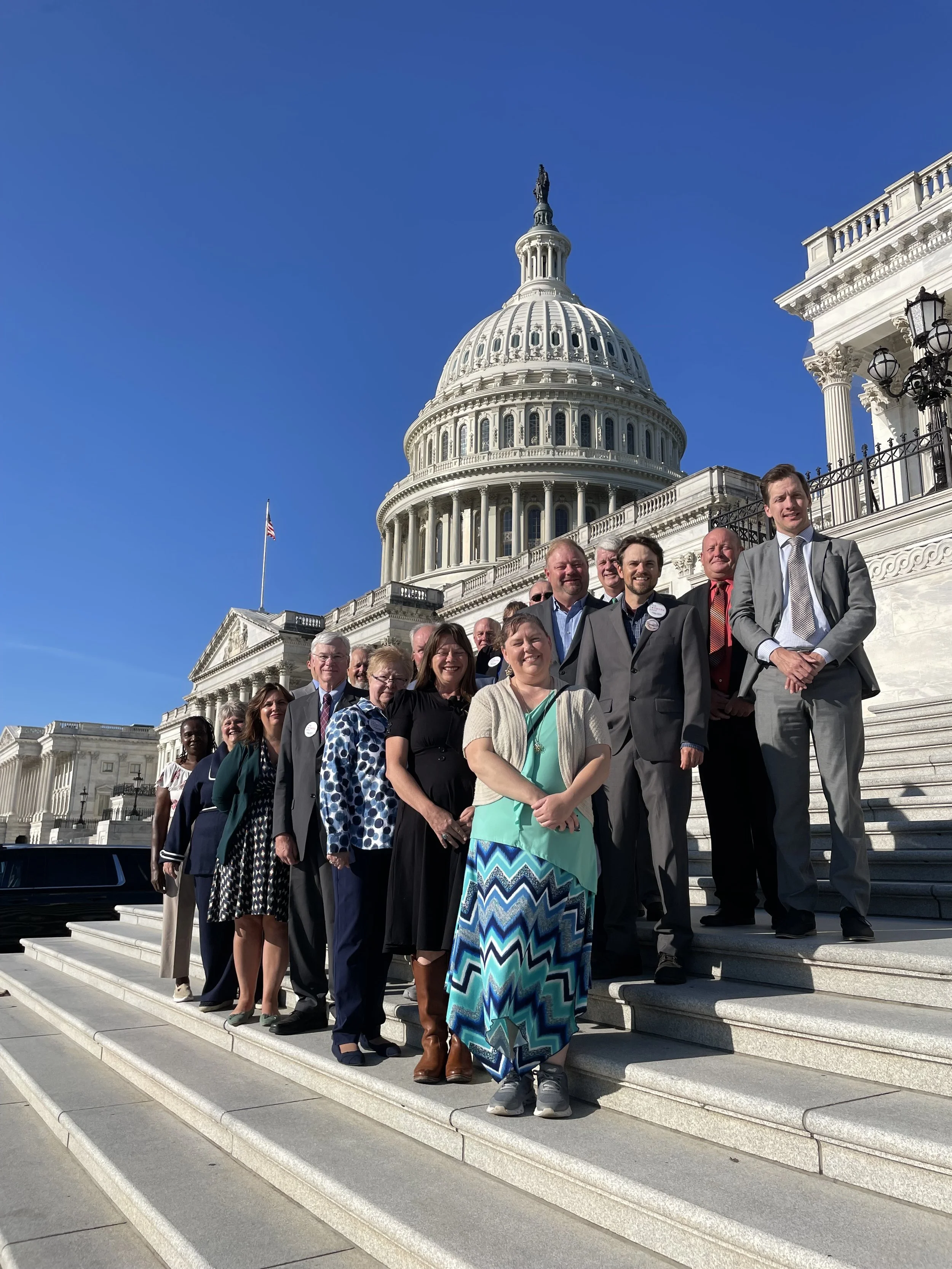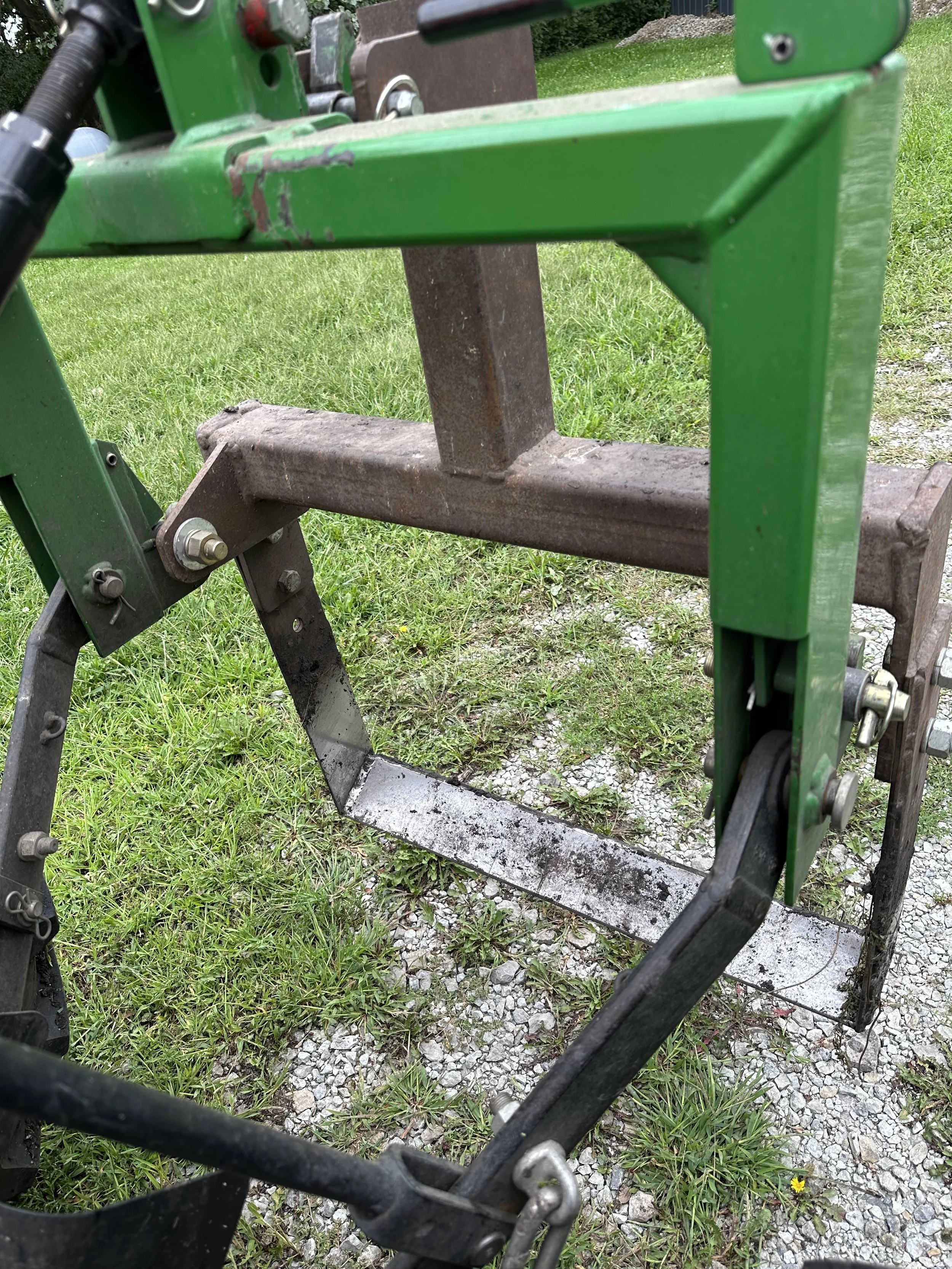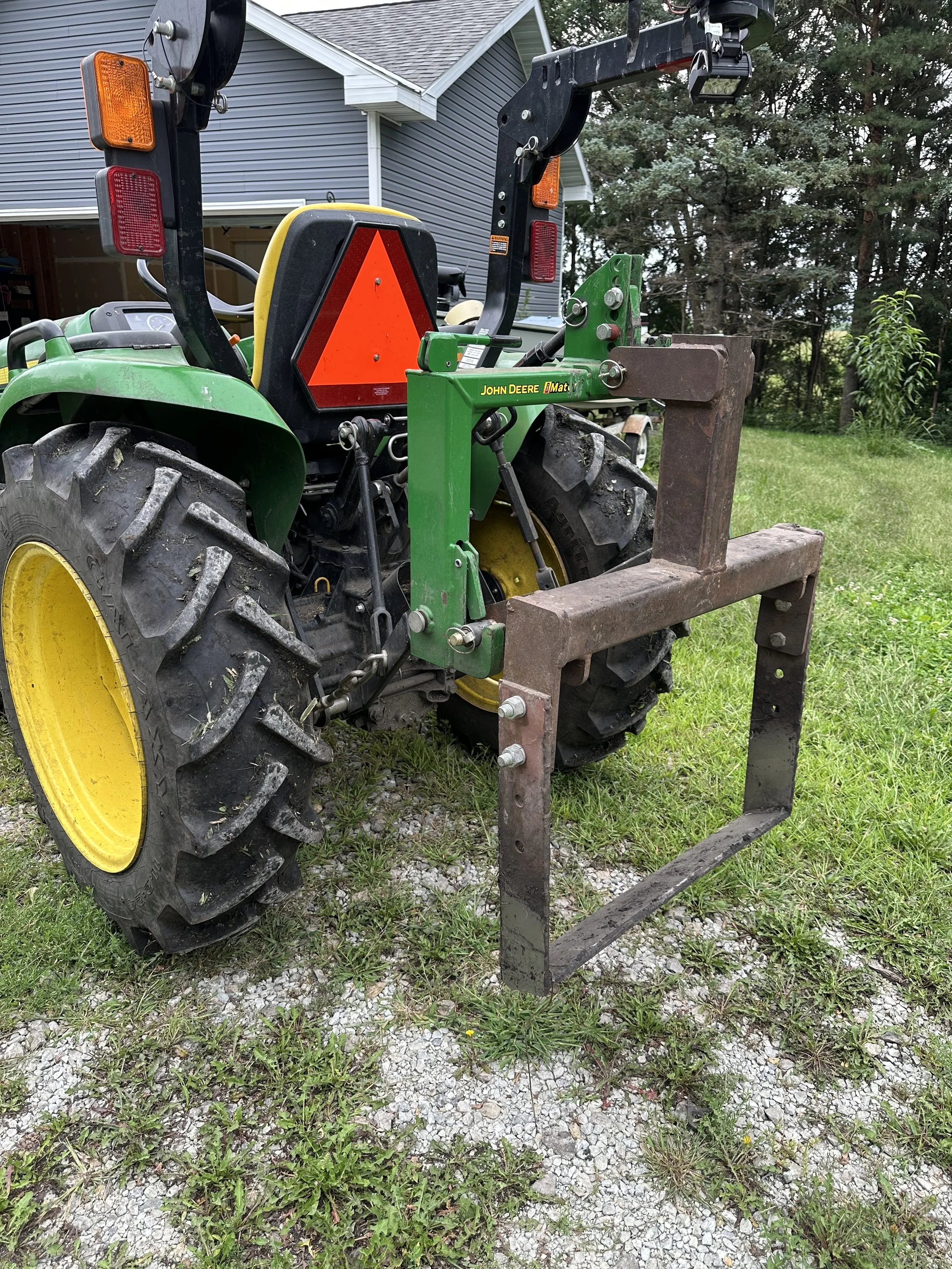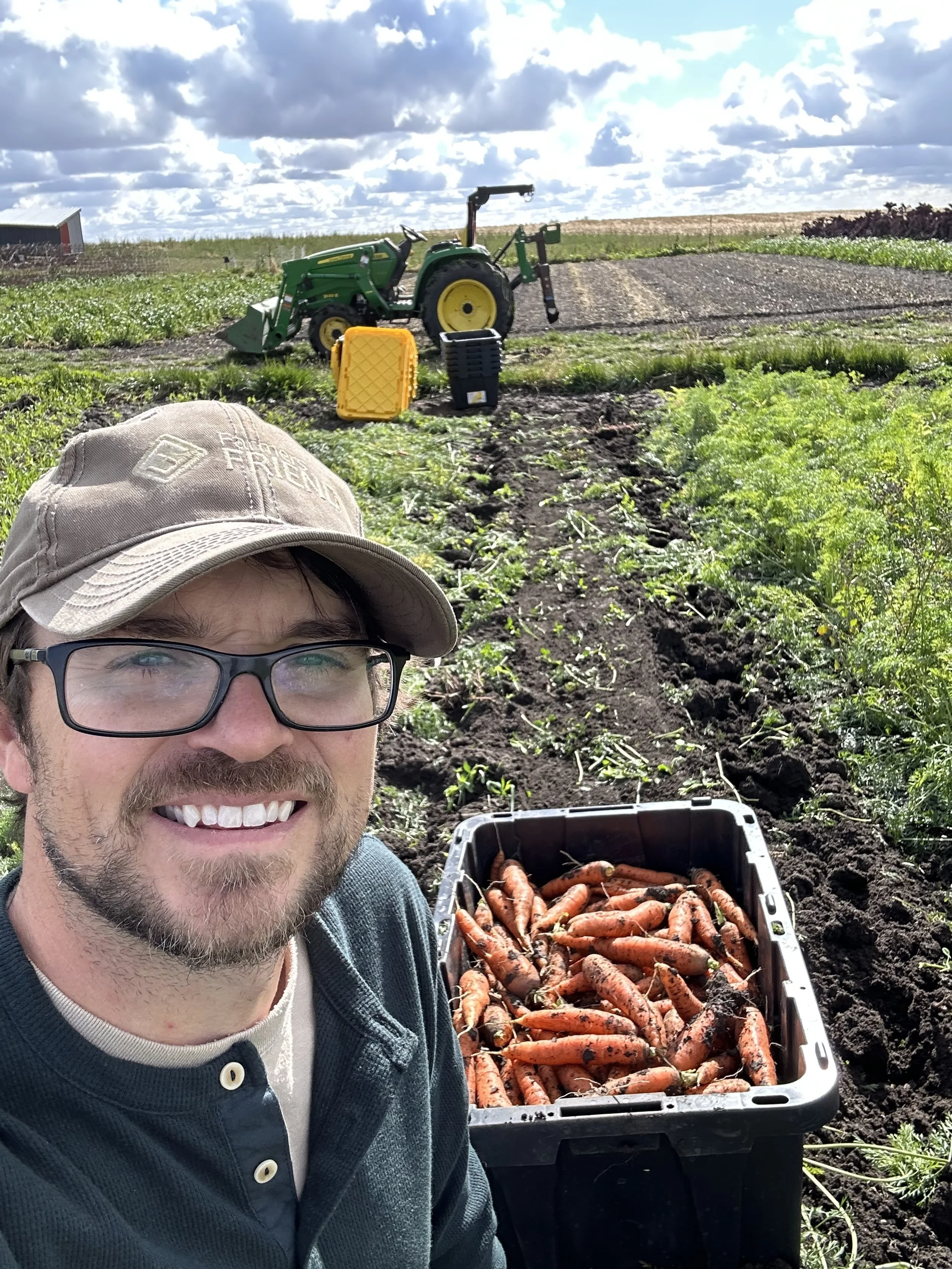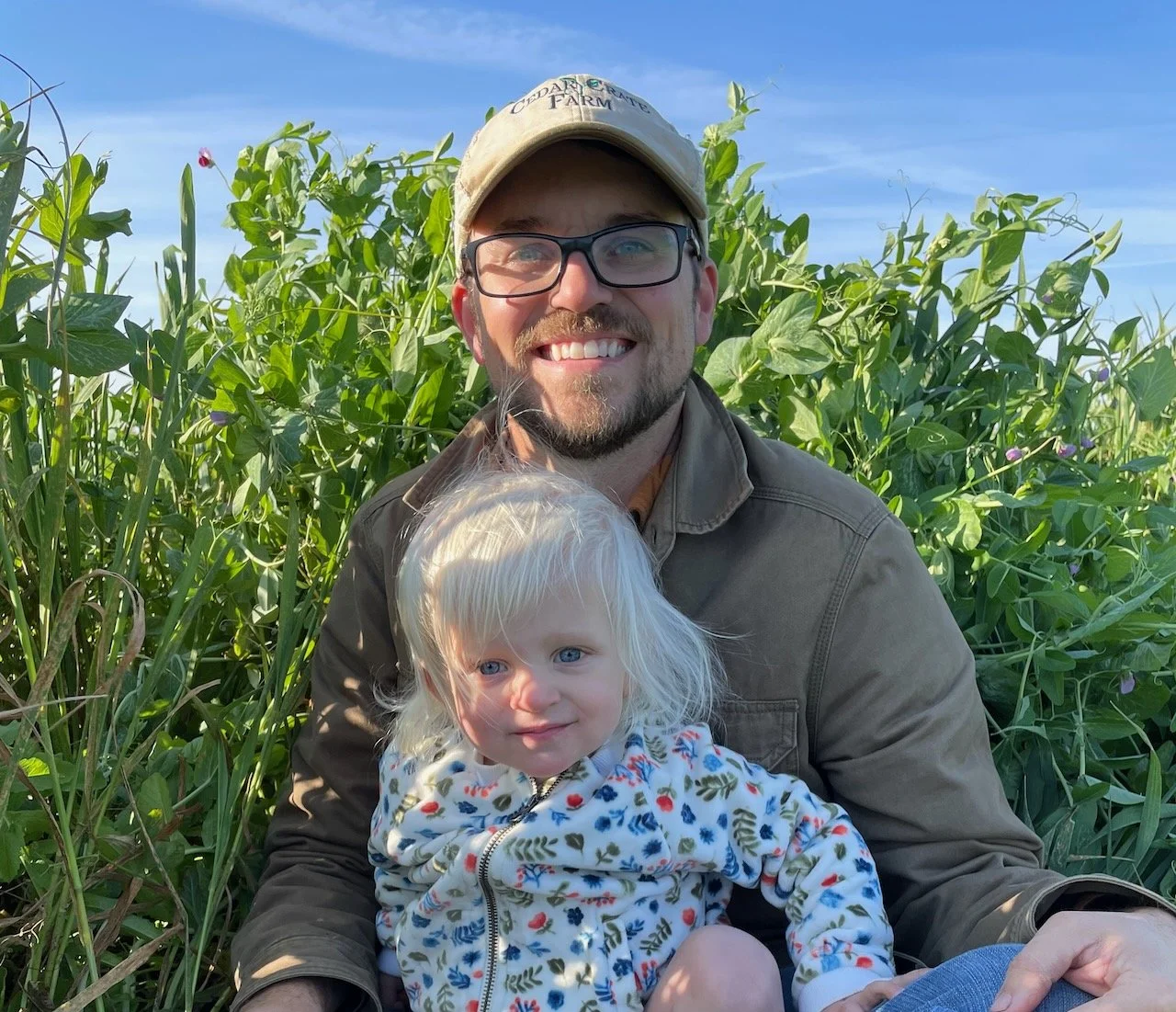
Winter Observations
My mom is always happy to have a fresh salad and I had noticed that we did have a very small amount of available in our tunnels that somehow survived outside temperatures of -20* F (+10* F in tunnel under row cover). I have been experimenting with winter growing for 5 years now and I was taken aback. I was happy to be able to harvest some lettuce mix to share with my family for our Christmas celebration. Observation is a critical part of farming produce and I wanted to share with you a few things I noticed in our winter tunnels this past week.
First observation, in the photo below, you’ll see some gorgeous spinach and tucked into the spinach is something else that caught my eye. Peas! These were part of our cover crop mixture and a few seeds ended up in our winter tunnel when we were broadcasting seed. I knew peas were cold hardy - that's why they were part of the cover crop mix - but the literature said they were good to the low 30s upper 20s.
Pea cover crop pictured center.
Second observation. Since I had noticed the peas surviving in the spinach bed, it got me thinking: I had planted the same cover crop mix intentionally in a different tunnel. I wondered what it might look like. See the photo below for the results While the oats in the mix are matted down and mostly dead, the peas that are part of the mix are still alive.
I’ve written about why cover crops are important in the past so I won’t get into it again today but know that I am tickled that these cover crops are continuing to do their job deep into the winter! I can hardly wait to see what the soil looks like in the spring when we start prepping these beds for new crops.
Oats and peas cover crop doin’ work!
Third Observation. Some of the lettuce varieties that constitute our lettuce mix are less cold tolerant and the size of the lettuce plant also matters with respect to cold tolerance. The rounded leaf types (red & green oak-leaf and butterhead) are much more cold tolerant than the pointy leaf types (red & green incised and sweet crisp). I don’t know why but I’d hypothesize that at a genetic and/or cellular level there are differences between the varieties that govern cold tolerance.
Lettuce picture from December 28th, 2025
An Observation on Observations: To tie a bow on this blog post I just want to note that this is just a small example of the observations that I, as a farmer, make to help in my decision making on the farm. Small observations can often be inter-related and can help inform my management decisions, crop/variety selection, and so much more. To be a good farmer, you really have to notice the details in your crops and think about what they might mean for the farm!
2025 Season Highlights
2025 was another year to remember with lots of big moments for our small farm. I thought it’d be fun go through our farms top 10 moments from 2025. Enjoy!
Welcoming Baby Aubrey! Our little farm family gained an extra set of farm hands this season with Aubrey arriving in January. Aubrey is the perfect addition to our family and her big sister, Addie, adores her!
Hiring our first Farm Manager. Katie, who many of you got to know this season, was hired as our first farm manager here on the farm. Katie did a fantastic job for us - she was fun to be around, had a great work ethic, was a natural at all things farming, and all around just a good person. I wish I could tell you Katie will be back next season but it sounds like Katie will be pursuing a farming venture of her own. We’re very excited for her!
MPR News Article! I’m a big MPR News fan and I’ve always loved the stories they tell about Minnesotans across the state so I was beyond excited when they reached out to do an article about our farm! This was a bucket list item for me and I loved the story they did. Sadly, I’m not able to find the article on their website so you’ll just have to take my word for it!
Home Delivery. Home delivery has proven to be a huge hit. The amount of gratitude folks have expressed for offering home delivery as a service has been huge and so rewarding. We know how chaotic life is, especially with children, so having your veggies show up on your door is a huge convenience for so many people!
Spring Tunnel Crops. Our high tunnels pumped out so many amazing crops this season. After loosing multiple beds of carrots in our high tunnels last season it felt really good to harvest and sell everything we grew in our high tunnels this spring.
Shallots. This year was our first year growing shallots and we were quite happy with the results. They were pretty easy to grow, extremely flavorful and held up in storage well. A little goes a long way with shallots. We’re planning to grow them again next season and are hoping for a little larger bulb size. We’ll see!
Carrots. We had an amazing year for carrots this season and brought in a record harvest. That felt really good since last season we had an abysmal year for carrots on account of the flooding.
Waterway Mix. It was another wet year so the time, money and energy we put into planting the waterway mix in our lowest areas really felt validating. One of the things I love about farming on a small acreage is you really get to intimately know the land and it’s patterns. We’re glad to have the waterway mix in place to protect our soil and our farm.
Lettuce. I’m really proud of the lettuce we grew this season. We had an ample supply every week throughout the entire season which felt really good.
Washington D.C. In September of this year I went to Washington D.C. to meet with Minnesota’s congressional delegation to lobby for farm policy that makes more sense. For me, it was advocating for the Local Foods Purchasing Assistant(LFPA) program that the Trump administration canceled early in the year. LFPA proved to be a vital program for not only farmers but main street businesses and folks experiencing food insecurity.
Tunnel Snow Management
We’ve just had our first big snow of the winter this past weekend. I don’t know about you, but I love winter and the snow but with is comes a different set of challenges. It might surprise you, but we need to carefully and thoughtfully manage snow around our tunnels even if they don’t have crops actively growing in them. This is especially true for our smaller “caterpillar” tunnels pictured below.
It’s a bit difficult to judge scale on this photo but the tallest drift on the right side of the photo is around 4 feet deep.
Native Minnesotans will recognize the different types of snow we get here: the loose fluffy stuff, the heavy “heart attack” snow, and everything in between. The “heart attack” snow is the most dangerous for our tunnels since by volume it has the most weight but even the fluffy stuff and cause problems. Over time, snow will build up on and between our tunnels. One or two big snow events won’t matter that much but an entire winter's worth of snow events would build up enough snow to collapse or damage our tunnels. To get ahead of that we routinely clear snow from the roof and in between our tunnels.
Our tractor and snowblower doing work!
We make use of our tractor and snow blower to tackle snow removal from the tunnels. We have our tunnels spaced such that we can fit our tractor and snowblower in between the tunnels. The snow is blown either completely over the tunnel into the field in the case of the smaller caterpillar tunnel (pictured right above) or blown to the north away from the tunnels in the case of our larger gothic style tunnels (pictured left above).
Bonus Tidbit: Some snow is actually REALLY good for our tunnels in the winter. Around a foot of snow all the way round the base of the tunnels helps to seal the tunnel where the plastic meets the ground. This helps us in two ways. First, it stops cold winter winds from entering the tunnel. Second, it helps to insulate the ground around our tunnels which preserves precious heat the soil inside the tunnels.
Protecting Our Winter Crops
Winter is on the way and it sure felt like it this past weekend. In preparation, we installed our row covers inside our tunnels to protect our winter crops as we transition into winter. It’s important to protect our crops from temperature fluctuations and help preserve warmth in the soil as we head into winter. The warmer we’re able to keep our crops and soil, the longer into the winter we’ll be able to bring you some of the more delicate winter crops we grow like salad turnips and radish.
The photo below captures the gist of our setup. We have wire hoops that straddle each bed with white row covers that are held in place with bungee cords. The bungee cords aren’t totally necessary but they are handy for holding the row cover up while we harvest. The row covers are anchored into the ground at each end of the bed with large staples.
We use the wire hoops to help suspend the row cover over our crops without touching them (except for kale - it’s too big!) which helps both reduce disease pressure by keeping moisture off of plant leaves. It also helps protect the crops better - if the row cover is damp and freezes and is touching the plant leaves then there’s a higher chance that crop will be damaged. There is management involved with the row cover. Depending on the temperature, cloud cover, etc, we’ll need to uncover the crops each morning and cover them again a couple hours before sunset.
The row cover provides around 4-5* of temperature buffering. Add that on top of the tunnel which keeps the wind off the plants and gives a couple more degrees of temp buffering. Finally, we have some heat banked in the soil. Overnight the soil gives off some heat and the row cover helps keep that heat closer to our crops. Taken together, this system has allowed us to produce lettuce - our most popular crop - into December consistently.
Persephone Period Approaches
Here we are at the end of October and we’re quickly approaching what’s known as the persephone period. That is, the time of year when daylight falls below 10 hours of light per day. This date is important because it’s the key to timing our crops so that we can get a winter harvest from them. Why? It’s because plant growth essentially stops once daylight falls below 10 hours of light per day. This means that we need to time our winter crops such that they are around 80% mature by the first day of the persephone period. That’s around November 7th for our part of the state.
The complication is exacerbated by the fact that the daylight decreases slowly from the summer solstice and by time September rolls around we’ve lost enough daylight that it affects the "days to maturity” guidelines that our seed companies offer. Further, the cooler temps also slow plant growth. Taken together, getting the planting date correctly to have our winter crops 80% mature by the beginning of the persephone period is tricky.
The Persephone Period extends from November 7th until February 4th. Our winter spinach will see pretty rapid re-growth in February and March due to the increasing daylight and increasing temperatures. If we get the timing and harvests correct then we can do a harvest of our winter spinach in November - December and have those same plantings re-grow in time for harvest again in March. It’s always nice to get two harvests out of a single bed of spinach!
Our Winter Crop Plan
We’re near the end of the outdoor growing season but our winter tunnel growing season is just kicking into production. This week I want to go over our winter crop plan. I’ll go over the various crops we’re growing in our tunnels this year including two new varieties that we’re trialing for winter hardiness.
Lettuce
We’ve found that our lettuce mix varieties are actually incredibly cold tolerant and can handle temperatures as low as 15* inside the tunnel before we start to see damage to the plants. Most seasons this means we will have lettuce mix available for November and December. We also trialed a new-to-us butterhead lettuce variety called Landis Winter that is even more cold tolerant than our lettuce mix but the trade-off is that it’s more disease prone. Finally, we head from another farmer that our staple summer green curly lettuce is also incredibly cold tolerant. We’ll see how cold tolerant it is this year but I’m expecting it to be about as good as our lettuce mix.
Kale
We’re growing both red and green kale. We’ve found that adult size kale has about the same cold tolerance as our lettuce mix. The big problem is that the kale plants are fairly tall and far away from the ground which is our main heat source in the winter. The further up into the air the kale is the more likely it is to be damaged by cold temperatures. We hope to have kale available into December.
Spinach
Spinach is our workhorse winter crop capable of withstanding temperatures as low as minus 10 degrees. Spinach does this really cool thing during cold snaps where it drains the water from it’s leaves to protect itself from the cold. It looks like it’s wilted and dead but as soon as it warms up again the spinach looks good as new. Most winters we are able to produce spinach all winter long.
Bok Choy
We found a new-to-us bok choy called “winter yellow heart” where the seed company claimed it could handle temperatures as low as 5* in an outdoor setting. We’re excited to see how it performs in a tunnel with row cover. If successful, we could have bok choy into January.
Scallions
We’re trialing a new variety called ever green hardy that is supposed to be the most cold tolerant scallions available. Our standard variety does over winter but usually gets unsaleable after it gets below about 15*.
Radish & Hakurei Turnips
Both radish and hakurei turnips can handle some cold but usually once it gets below about 15* they suffer enough damage that they’re unsaleable. We’ll probably have turnips and radish into early December.
Mizuna & Tat Soi
Similar to radish and lettuce mix both Mizuna and Tat Soi can handle the cold to a point. Once mature they will be part of our winter mesclun mix. Look for that at the end of November and early December.
We’ve heard that we’ll be in a La Nina weather pattern for this winter which means colder and wetter than usual. The cold is a bit concerning: if we get too cold too fast or have a polar vortex early it could damage many of these crops before we’re able to sell them. The extra precipitation is good though. The snow can help to insulate our tunnels and help our crops to survive the coldest temperatures.
We really enjoy pushing the boundaries on what’s possible in the winter in southern Minnesota. We learn a lot each winter and it is SO satisfying to bring fresh greens to CSA shares and winter farmers markets long after the first snow flies! We will continue to push boundaries and find innovative ways to bring fresh produce to market season after season.
Looking Ahead to 2026
A Preview Of Our 2026 Season Plans
This is the counterpart piece to my 2025 Season Reflection post from a few weeks ago. Every year we begin a reflection process in the fall that looks back at what went well and what didn’t with a goal of formulating a plan for the coming season. In just a few weeks I’ll be placing our seed order and putting the finishing touches on our 2026 crop plan. Here are some of the things we’re looking at changing or improving for 2026.
More Tomatoes! We couldn’t keep tomatoes in stock this season. We sold out quickly, routinely, week after week until mid September. We have a couple ways we’re going to address this. First, we will grow at least 2 additional beds of tunnel tomatoes. We’ve found the tunnel tomatoes are the best quality, best flavor, and most reliable when compared to their outdoor counterparts. We’re also going to plant more heirloom style tomatoes outdoors with a florida weave trellis system and light pruning. We’ve seen a number of other farms do this and we think this will be a great way to increase our tomato offerings.
Better Onions We had problems with onions this past season that I outlined in my reflection post. Here’s how we’re going to address this problem. First, we’re going to scale back the amount of onions we grow to a more realistic number. This should give us more time to take care of the onions we do have so that we reduce (eliminate?) the curing issues we had this season. Second, we’re going to grow some bunching style onions, similar to scallions but with bulbs, that will help offer more variety and more flavor to our onion offerings. We’ll also look into switching up varieties but haven’t decided yet.
Strawberries. We know when we take adequate care of our strawberries that we get good results. We’re re-prioritizing strawberry care so that the necessary jobs get done on time. This should mean more strawberries available sooner in the season.
Shallots. We really enjoyed having these in our own kitchen this season. We’ll be looking to grow a variety that gets a little bigger but shallots are here to stay!
Potatoes. We’re kind of taking the same strategy here with the potatoes as we did with the onions. Growing less potatoes but focusing on better care and quality.
Peppers. This a more behind the scenes look but we grew too many shishito, serrano and banana peppers this season so we’ll be tweaking our plan to bring it more in line with what we can sell.
Peas. We were short on snap peas this year. We had trialed a new trellis method that didn’t work very well so we’ll be moving back to our typical netting and support rod trellis. It’s more work but it results in a much easier harvest and better yield. We’ll be planting more snap peas AND if we can figure out a space inside our tunnels to squeeze some peas.
More To Come: The 2026 seed catalogs haven’t come out yet but we know we’ll probably be inspired by something in the catalogs.
Winter Tunnel Finally! As I write this we are in the process of obtaining financing and construction quotes for a fully featured winter growing structure. We hope to put it into service next season and have the first crops grown within be the tomatoes described above. We’ll see how the timing goes!
Partner Farm Products. We want to expand our partner farm product offerings for more reliable inventory and to try to get closer to a full diet farm. We’re looking for partners for baked goods, dairy, meat & poultry, maple syrup & mushrooms to really round out our offerings.
Overall, we’re looking to eliminate as much waste as possible while having more variety. The better we do at this the better our CSA is and the better our farm does as a whole!
2025 Season Reflection
As usual at this time of year I start to really think about how our farming and CSA season went this year and consequently, what changes I want to make in 2026. This post is really meant for our CSA members but if you’ve been following along this season I think you’ll find some interesting tidbits of information in this post. This will be a long one, enjoy!
What Went Well?
It’s probably best to start off on a positive note and go over the things we’re really proud of or that we felt like went really well this season.
Our Farm Staff and Especially Our Farm Manager Katey. Overall, we had great staff this season. Our staff were great workers and worked well as a team. They were very reliable and they helped us make some efficiency improvements around the farm to boot. In particular, our Farm Manager position and Katey who is our Farm Manager this season worked well. The Farm Manager position is new to us this season but our goal was to offload some of the managerial duties from my (Dan’s) plate so I could focus more on the farm and the business. It also allowed us more flexibility with the farmers market and allowed us to leave the farm without much stress at all!
GrownBy. The jump from Harvie to GrownBy was one of the biggest changes we’ve made to our CSA in years but we are so glad we chose GrownBy as our CSA management platform. GrownBy has allowed our CSA members more flexibility and made our management simpler as well. Plus GrownBy is a co-op and we are part owners so we get a say in the direction GrownBy takes in the years to come. We especially love the way vacation weeks work in GrownBy which offers our CSA members much more flexibility on the weeks they’re unable to pick up their shares.
Lettuce. I think this season is our best season yet for lettuce. We’ve had a very consistent supply throughout the entire season which has always been our goal. Even during the hardest time of year from about July 20 through September 1 we had a steady supply.
Shallots. I don’t know about you but I love having a stash of shallots at the ready for eggs, fried rice, sauces & whatever else. We’re definitely growing shallots again!
Fall Broccoli. We’ve had so much broccoli this fall and it’s been great. I think we’ve finally settled in on some varieties and a production cadence that works for us.
Carrots. This season has been a good carrot season for us. Our early tunnel plantings were just phenomenal and our field plantings were great too. Our biggest trouble with carrots this season was finding a time in between all the rain to dig them! Our storage carrot plantings are looking amazing too so we’re anticipating having literal tons of carrots available. After a dismal carrot year last season this is a welcome change!
Scallions. Both the purple and white scallions will be back next season. We just love these - they’re so flavorful and versatile and we have them available for so much of the season.
Tunnel Tomatoes. I hesitated for a moment because there’s a lot of room for improvement here but overall I’m happy with how our tunnel tomatoes went this season. They yielded a bit better than last season and we have been selling through them as fast as we can pick them. We’ll be looking to double or maybe even triple our tunnel tomato production for next season!
Peppers. They took their sweet time this year but our peppers have been yielding really well this season and they taste incredible. In particular, we really liked the addition of the yellow carmen pepper and Serrano peppers. The yellow carmens are just as good as red carmen and are beautiful. The Serrano peppers have been one of my favorites with their steady heat and fruity flavor.
Green Beans. I’m really proud of the fairly steady supply of green beans we’ve had available this season and they’ve been really tasty.
Home Delivery. Lastly, home delivery was a success this year. We were nervous going in about the costs and the time but after we settled in on our route and added new customers it became a really great way to sell our produce.
There are other wins we had this season but those are some of my favorites. We would love to hear from you about anything you thought really stood out this season!
What Didn’t Go So Well?
Ok. Now for the less fun part: talking about the things that didn’t go as well as we hoped. A combination of human error and unpredictable weather inevitably leads to crop failures or mistakes of some kind. Here are some that are front of mind for me.
Storage Onions. We’ve heard from a few CSA members about poor quality storage onions. This is sort of a problem on multiple fronts. First, is the weather. Not a lot we can do about the weather but it was too wet for obtaining top quality storage onions. Second, we had about twice as many onions planted as we needed. This ended up meaning that they needed one more weeding pass that we didn’t have time to get to. Removing the weeds would have helped them dry out faster and reduced disease pressure. Third, sorting onions. We did our best to sort out the bad ones in the field and when we pack your shares but things still fell through the cracks.
We’re going to be doing a big revision on our onion planting plan and we hope to incorporate some new varieties of onions and streamline this a bit more. Stay tuned!2nd Sweet Corn Planting. This one was a doozy. First, it was ripening while I was on vacation off grid in the boundary waters. Second, we saw intense raccoon pressure more than we’ve ever seen in 10 years of farming here by an order of magnitude. Couple those two things with staff that weren’t quite trained in/experienced enough (still my fault) and we ended up with way under ripe corn being picked and distributed.
Luckily, our subsequent plantings were some of the best corn we’ve ever grown!Strawberries. We planted twice as many strawberry plants as last season but they yielded half as much. I hate to admit it but it was mismanagement on my part. We needed to pluck the first flowers which we didn’t do. We needed to keep them weeded better which happened too late in the season. Finally, we needed to pull the runners on them which didn’t get done frequently enough. We’ll be re-prioritizing these tasks for next season because we know you all love fresh strawberries!
Red Potatoes. We had an extremely poor yield on our red potatoes this season. Red potatoes are typically ready about mid-July so my theory here is that it was just too wet when the potatoes were sizing up. Our white potatoes were planted and managed the same way and they yielded much better.
Peas. We just didn’t have as many peas as we wanted this year. We planted these a bit too early and ended up with a poor stand of peas. Couple that with our main pickings of peas falling on our July 4 break week and the wet weather and we just didn’t have peas available for CSA members anywhere near as much as we’d like.
Acorn Squash. We had poor germination on our acorn squash this year. It was so poor that we ended up terminating the planting.
Beets. We had something like 4 consecutive plantings get washed out by heavy rain which has caused a huge 2 month gap in our beet availability this season.
Cilantro. Similar to beets, we had 3-4 plantings of cilantro get washed away by heavy rain. Further, this was during peak salsa and tomato season meaning we missed a critical window for cilantro availability!
Field Tomatoes. We had a terrible field tomato crop this season. The harvest was very small and the tomatoes that were there were very small. We think this was a combination of a somewhat late planting, wild fire smoke, excessive rain and potential carry over disease pressure from last season. We’ll be making some changes to our field tomato planting plan for next season so we have a better harvest.
Ultimately, every year is different from the year before. Every year we learn a lot. Every year we try some new things. Every year we make mistakes. Every year we learn and grow. I think that’s part of the joy of farming produce. The elusive perfect season always seems within grasp but never fully materializes. I now look forward to dreaming about how next season will be the best season yet!
First Frost Of The Season!
As I sat down to write this latest farm blog post I noticed my most recent post was about the fall heatwave. Funny that less than a week later we experienced the first frost of the season! That’s a nearly 60 degree temperature swing from our high of 90 on Friday to the low of 32 overnight on Tuesday night/Wednesday morning. Crazy!
We actually managed to save our bell peppers and sweet peppers from the frost using a irrigation method we read about that orchards sometimes use in the spring. We got up in the middle of the night and turned on our overhead irrigation on our peppers on Tuesday night and let that run through until the next morning. The idea being that because it takes a lot of energy to do the phase change from liquid to ice you can protect your plants from the cold temps. It seems to have worked! With a rather pleasant forecast for the next week or two we should continue to have bell and sweet peppers available!
This first frost was not unexpected - we typically plan for about October 1 for the first frost so that’s about on schedule. We didn’t lose any crops we weren’t prepared to lose and it actually helps improve some of our fall crops flavor. Crops like lettuce, carrots, cabbage, broccoli & kale all benefit from a light frost. It makes them sweeter and can improve texture as well. This happens as a defensive function from these crops: increasing the sugar content in the plant cells decreases the temperature at which the cells will freeze and burst potentially killing the plant. Pretty neat!
A frosty morning last Wednesday, October 8th!
Fall Heatwave And Its Effects
We’re in the midst of a fall heatwave here on the farm and basically everywhere in the upper Midwest. Highs today and tomorrow are forecast to be in the low 90s and it’s the first week of October. That’s around 20-25 degrees above the average. This kind of heat has an effect on our crops here on the farm and it’s a bit of a mixed bag. Some crops benefit from this heat while others suffer. Let’s break it down.
Crops That Benefit
Our summer-loving crops like green beans & peppers benefit from this heat. The green beans continue to produce as do the peppers. In fact, this heat is a bit of a blessing for the peppers. Our peppers were a bit delayed this season in ripening and since our average first frost is around October 1 (but could come sooner!), this heat has really moved along our peppers in terms of ripening. We’re picking pecks of perfect peppers weekly and they are just stunning this season!
Crops That Suffer
In particular the crop that we’re having the hardest time with during the heatwave is our winter spinach. We seed spinach from roughly late August through early October with the intention of having spinach available for CSAs, online orders, and our farmers market stand from Early October all the way through winter into early next spring. Our first planting of spinach didn’t germinate well at all. So much so that we had to terminate that planting. This is because spinach is very sensitive to soil temperate: it prefers cool soils for optimal germination. Our second planting from early September came in a bit better but we needed to interseed additional spinach to justify the space in our winter tunnel. Our late September planting of spinach came in much better and we’re excited about that planting.
Our 3rd planting of spinach came in well!
Fall Cover Crops Emerge!
Healthy soil is the foundation of our farm. We believe healthy soil = healthy food = healthy people. One of the ways we make sure our soil is healthy is by planting cover crops. Cover crops have a variety of benefits including protecting the soil from erosion, adding organic matter to the soil which feeds the soil, providing habitat for insects and scavenging nutrients that future cash crops can use.
We had a very nice rain last week totaling just over a half inch just a couple days after I had planted our fall cover crops. This combined with nice weather caused our cover crops to emerge quickly. The forecasted continued warm weather will ensure our cover crops get off to a good start and provide maximum benefit before they succumb to the inevitable cold.
Our fall cover crop mix consists of oats, peas and faba beans. This mix of cover crops main benefits are preventing soil erosion, adding organic matter to the soil and fixating nitrogen, a critical plant nutrient, from the air. The oats are great for protecting the soil and breaking up any compaction. The faba beans will fix some nitrogen and have a tap root that can penetrate hard pan. Finally, the peas will fix nitrogen so we have more nutrients available for next seasons crops!
Cover crops emerge!
Topping Tunnel Tomatoes
The signs of the inevitable season change are mounting. One of those signs - the topping of our tunnel tomatoes - came this past week. What is topping tomatoes? Why is it important and what is it’s purpose? We’ll go over the reason we top the tomatoes and the results we hope to see.
As a refresher, the tomatoes we grow in our tunnels are an “indeterminate” variety meaning that they will continue to grow until either the frost gets them or they succumb to disease. We’ve written about how we manage that growth in several blog posts over the course of the season.
So what is topping tomatoes? It’s basically exactly like it sounds: we cut the top of the main stem completely off so that no further vegetative growth is possible. Why would we do such a thing?!
A topped tomato plant. Notice the flowers (fruit truss) just below the cut stem.
We know that the first frost is approaching. Most years we see that happen in the first half of October and usually closer to the beginning of October than the middle. Because of that, we waste plant energy and vigor in trying to continue the vegetative growth. By topping the tomato plants, we force the plants to focus their remaining energy on growing out the last of the tomatoes for the season.
We’ve left enough tomato fruit trusses to allow about 4-5 weeks worth of tomatoes. We figure we will get about one truss worth of tomatoes per week per plant. It’s a little bit of a moving target as the daylight decreases day after day and the temperatures fluctuate more so this time of year. Both of these, have an impact on how fast tomatoes will ripen!
So while the signs of seasonal change mount we will still have about a month of tomatoes left. Summer isn’t quite over yet!
Recap: Lobbyist for A Day
I’m back from my trip to Washington D.C. to help the Minnesota Farmers Union lobby for policies that benefit farmers and rural America. Politics has been a touchy subject for quite some time and I’m guessing this blog post might stir up some feelings or opinions and even disagreements. I’m hoping to write from a place of fact or at least facts as I understand them. Feel free to disagree with me and the Minnesota Farmers Union about what policy priorities for farmers and rural America should be. In fact, I’d love to hear your take because I bet I can learn something from you!
I went as part of the Minnesota delegation for the Minnesota Farmers Union which is part of the larger National Farmers Union. Their slogan is “for farmers sake” but really it should be “for everyone's sake”. After all, the slogan “Agriculture is the foundation of manufacture and commerce” was one of the first things I saw as I entered the USDA building. Without agriculture cities aren’t possible and we’d all be back to hunter-gatherers.
I’ll summarize the main policy priorities we had briefly below:
Restore Local Food Procurement Programs. The now defunded Local Foods Purchase Assistant program was incredibly popular across the country and even across political ideology. We advocate for a house and senate bill introduced with bi-partisan support to restore funding for a replacement program.
Break Up Corporate Ag Monopolies. Did you know that just 4 companies control something like 80% of all beef, pork and poultry processed in this country? They disguise this by selling their products under different brand names and different labels giving the illusion of choice.
Pass A Farm Bill. The Farm Bill is a collection of programs that benefit farmers, rural communities and folks experiencing food insecurity. The farm bill includes things like SNAP (food stamps), crop insurance and conservation programs.
Tariffs/Trade Policy. End blanket tariffs.
Biofuels. Expand use of ethanol and biodiesel with a nationwide E15 program.
Meat Labeling. Country of origin labeling for meat. Not everything labeled “product of USA” is an animal that was grown or raised in the USA.
Before I get into my take on these policy priorities and reflections I wanted to just say that the Minnesota Farmers Union delegation I was a part of was a diverse mix of growers. There were several vegetable growers, livestock producers, cut flower producers and more. That’s something I really like about farmers union: we’re a diverse mix of growers advocating for farm policies that work for all farmers.
We met with either the congressional members themselves or their staffers and in some cases both. I personally met senators Amy Klobuchar and Tina Smith as well as representatives Angie Craig, Kelly Morrison, and Betty McCollum. I also met with a staffer from representative Brad Finstad who is my representative here in district 1. Our group also split up so we could meet with staffers from Ilhan Omar, Tom Emmer and Michelle Fischbach’s offices respectively.
Here are my take-aways from the meetings. First, the meetings are so short and so brief that it’s really hard to dive into the nuance and details of various policy issues. Democratic representatives seemed largely supportive of our overall policies priorities while Republican representatives were more muted in their responses. Reading between the lines we know Republican representatives see the problem brewing in the rural economy but they were very hesitant to offer up solutions.
Another takeaway is that it seems there is bi-partisan support for enacting a Local Foods Procurement Program similar to the Local Foods Purchasing Assistance Program that was canceled under the Trump administration. There are currently bi-partisan bills in both the house and the senate that would re-create this program.
A third takeaway is that both Republicans and Democrats recognize the problem tariffs have created for farmers. The problem boils down to this: China buys basically 1 out of every 3 rows of soybeans produced in the United States. Further, China buys a large amount of pork (which is fed crushed soybeans) from the United States. Usually, by this time of year contracts are signed for China to buy a certain amount of soybeans but this year there are no contracts. Soybean prices, and most commodity prices in general are depressed.
Democrats see this as a self-inflicted wound while Republicans are both hopeful a better trade deal will come and also recognize that a single buyer, China, buying that large of a percentage of U.S. commodities is a weakness and that we should diversify our exports. I think both are right, it's just too bad it’s coming at the farmers profit.
Both Republicans and Democrats are skeptical that a farm bill will be passed by the end of the year. Tina Smith described the farm bill as the “grand bargain” where democrats who support strong social safety nets through the SNAP program and republicans who support a strong farmer safety net could come together to pass a bi-partisan bill. The problem is that Republicans drastically cut SNAP benefits in the One Big Beautiful Bill Act without Democrat support through the reconciliation process. Both Representative Angie Craig who is ranking member on the House Ag Committee and Amy Klobuchar who’s on the Senate Ag Committee foresee difficulty getting democratic support for a farm bill because democrats will be unwilling to vote on anything that doesn’t restore SNAP benefits. Likewise, some republicans will be unwilling to vote on a farm bill that includes SNAP benefits due to budget concerns.
My own view is that it was either incredibly short sighted for Republicans to vote to cut SNAP and expect to pass a farm bill in the future OR that Republicans really don’t care about passing a farm bill. Given the muted response overall from Republican staffers it seems to me that this whole farm economy is designed to bankrupt the small commodity farmers. The big will get bigger and the small will whither.
Our farm, Cedar Crate Farm, is lucky. We are not reliant on government programs like subsidized crop insurance or direct payments from the government. We can’t be forced out of the market by low commodity prices, a lack of an adequate farm bill (which really doesn’t do much for us), or slow government payments. Despite direct marketing being significantly more work we largely operate outside the government agricultural system which gives us a good bit of resilience when it comes to poor trade policy and congressional infighting. One tidbit I picked up that I find interesting is that a commodity farmer that was on the fly-in with me shared that about 25% of their gross farm income comes from direct government payments. And remember, that doesn’t include crop insurance premium subsidies.
The last thing I’ll hit on is bio fuels. My initial reaction is that biofuels are not the best idea ever. It seems like we as a country are over producing commodities and trying to drum up new ways to use these commodities by subsidizing new markets. If gallon for gallon ethanol and gasoline were equal it might be a different story but my own experience is that I see a 10-30% reduction in mileage in my vehicle when I use the highest ethanol blend my vehicle supports. I do see how a gallon of ethanol is more environmentally friendly than a gallon of gasoline since there’s some amount of carbon that’s offset in the production of ethanol. That said, the biofuel issue is not a hill I would die on and if it helps my neighbors then it is something we might as well do.
I walk away from this fly-in and my experience in Washington D.C. with a mix of feelings. First, I feel a little more patriotic than before not only being in DC but also participating directly in the democratic process at the federal level. It’s hard to be in DC and not feel patriotic. Conversely, I feel pessimistic about Democrats and Republicans coming together to work on policies that benefit farmers and rural America. I feel proud that my farm is able to function without government support. I feel jealous that commodity producers get so much government support. The experience was intense and intimidating but I learned so much. I’m grateful for the opportunity and was glad I had a chance to make my voice heard.
Lobbyist For A Day
About a month ago I was invited by the Minnesota Farmers Union to attend their fall “fly in” event where I will join farmers from across our state and across the country too to lobby for farm and rural policy in Washington D.C. It’s a busy time of year for our family with back to school, the farm still producing in full swing and the seasons changing but I couldn’t pass up this opportunity. It’s not everyday you get an invite to potentially meet with your congressional delegation to advocate for yourself.
In the prep call that the Minnesota Farmers Union held they emphasized telling a personal story as it relates to farm policy. There’s a lot of federal farm policy that doesn’t support farms like mine. Most of the money, most of the programs, and most of the investment in farming goes to corporations, large corporate farms, and commodity farms (in that order). One of the few programs that helped and benefited not only farms like mine but our community more broadly was the Local Foods Purchasing Assistance (LFPA) program. Essentially, you can think of it as the Federal Government subsidizing local food production in a similar way to how commodities like corn and soybeans are subsidized.
Sadly, LFPA was canceled with the new administration which we talked about and described earlier this spring. I understand that tucked into the new farm bill is a version of LFPA which I intend to encourage my representatives to support. Not only does LFPA benefit farms like mine but it also benefits businesses that purchase goods from our farm to process into ready to eat meals for a variety of people including children and food insecure folks. Further, LFPA really helped us last season when we experienced catastrophic flooding and hail. It allowed us a market outlet for our seconds and produce that wasn’t fit for our market stand or CSA boxes giving us a much needed source of income when many of our crops were flooded out or damaged.
I’m looking forward to the opportunity to share my story, our farms story, and the impact these programs can have on our community. I look forward to writing the follow-up blog to let you all know how it went!
Why Farm Fresh, Local Produce Tastes Better
Or why grocery store produce doesn’t taste good.
When I started Cedar Crate Farm back in 2015 I had one distinct problem that I wanted to solve for people. The problem is that grocery store produce doesn’t taste good. I knew that because I had grown up eating produce fresh from my mom’s large garden. I knew what fresh produce was supposed to taste like. I knew that the grocery store was selling an inferior product. I knew that I could grow better tasting produce and share it with this community in south central Minnesota.
Why Grocery Store Produce Doesn’t Taste Good
The reasons for that are many but we’ll go over a few of the key reasons briefly here. The first reason that grocery store produce doesn’t taste good is that the produce varieties that grocery stores carry are varieties selected for their ability to withstand shipping and shelf life. This is almost always at the expense of flavor.
Take our incredibly delicious and incredibly popular Sungold cherry tomato. It’s known for it’s incredible sweet flavor that’s almost like candy. It’s also known for it’s propensity to crack during shipping. Because of it’s propensity to crack you’ll never find it in any grocery store but you will find it in your CSA shares, our online farm store, and our farmers market stand.
The second reason grocery store produce doesn’t taste good is because it isn’t fresh. Most produce in most grocery stores (even some food co-ops!!) isn’t local. It isn’t even grown in the Midwest and in some cases isn’t even grown in this country. If you think about the steps the produce takes it could be a week or more since that produce was harvested and when it ends up on your table. Here’s what it might look like:
Produce is harvested and spends time on the farms harvest, wash & pack line. 1-2 days.
Produce is shipped to a distribution center. 1-2 days.
Produce is shipped again to the grocery store. 1-2 days.
Produce is in the grocery stores receiving area/walk-in cooler. 1-2 days.
Produce sits on the grocery store shelf until it spoils or you buy it. 1 - ??? days.
Best case scenario is the produce is 5 days old when you purchase it from the grocery store but probably a lot longer. No wonder it doesn’t taste good!!
Our farm solves this problem by growing the best tasting varieties of produce we can find! Further, we always harvest, wash & pack your produce the day before we deliver ensuring you always have the freshest, best tasting produce possible!
How We Dig Carrots
Carrots are one of our most important crops on our farm and something we’re known for. Each year we grow literally thousands of pounds of carrots for our CSA members, online store, farmers market & whole sale partners. When you’re digging that many carrots every season you need a better, faster and easier way to dig carrots than a simple shovel, broadfork or potato fork. We use a tractor attachment called a bed lifter to make digging our carrots much easier.
The bed lifter is a simple tool overall. It works by digging underneath the depth of the carrots and loosening the soil. This enables us to easily pull the carrots out by their tops for harvest. It greatly increases the amount of carrots we can dig and it’s a lot easier on our backs as well.
There are a couple tricks to using the bed lifter. It needs to be deep enough that we don’t slice off the bottoms of the carrots but not so deep that the carrot cling to tons of dirt and mud. The angle of the cross bar at the bottom needs to be gentle enough to not break the carrots but steep enough to loosen the soil. And the soil conditions need to be right. If it’s too dry the soil breaks apart in huge clods breaking carrots and not greatly improving the speed. Conversely, if it’s too wet we aren’t able to use the bed lifter because we’d either get the tractor stuck or not have enough traction to pull the bed lifter.
Why Cover Crops Are Important
Farming in a sustainable and earth friendly manner is one of our primary farming values on our farm. We seek to not only maintain but improve the land we farm on over time. In the grand scheme of things, the time we spend farming this land is pretty small and we want the next generation of farmers to be able to succeed. Not only that but we also want to protect the soil, air and water so that our farming footprint stays confined to the acres we farm. One of the key ways we work towards this goal is by planting cover crops. Today we’ll go over why cover crops are important and what cover crops we plant on our farm.
First, we should define what a cover crop is. For us, a cover crop is a crop that we plant whose primary purpose is to improve our land. Further, a cover crop is not planted with intent to harvest and sell a product.
Our summer cover crop mix. The plants with white flowers are buckwheat. The long slender leaves that resemble corn are millet.
Cover crops serve a variety of purposes on our farms and many farms in general. Their benefits include reducing soil erosion, suppressing weed growth, providing habitat for beneficial insects, and improving soil health. Our primary goals for our cover crop mixes are to suppress weed growth and improve soil health. That’s not to say the other benefits are not important - they are. It’s just that when we look at which cover crops to plant we are seeking to achieve those goals primarily and the other benefits secondarily.
We have two mixes of cover crops that we use on our farm to achieve the goals of improving soil health and suppressing weeds. In summer we plant a summer mix of cover crops. That is, crops that grow well in the heat of the summer. This mix includes species like buckwheat, soy beans, sun hemp, sun flowers, millet & more. In the fall we plant a mix of peas, oats & phacelia. These crops grow better in the cooler temperatures of fall and can grow later into the season than our summer mix. Our winter mix is capable of withstanding frosts.
To suppress weeds we seed our cover crops pretty densely and lightly incorporate the cover crop seeds into the soil. With a little rain the cover crop comes to life creating a thick mat of vegetation that crowds out weeds. In our experience, we’ve observed that the areas where we plant cover crops are generally much easier to weed the following season.
Cover crops improve soil health in a few primary ways. First, some cover crops like peas can pull nitrogen (a primary plant nutrient) out of the air and store it in the soil for future crops to use. Cover crops in general also contribute to soil organic matter which microorganisms in the soil feed on. These micro organisms then metabolize the cover crops and leave behind nutrients future crops can use.
Many of our cover crops also achieve our secondary goals of reducing soil erosion and providing beneficial insect habitat. Because we’re planting pretty densely and minimizing fallow ground by using cover crops we are reducing soil erosion. Additionally, buckwheat - one of our primary summer cover crops - flowers quickly and the bees love it. Buckwheat provides habitat and forage for the bees!
Cover crops are an important part of sustainability on our farm. We’re always looking for new species and new mixes of cover crops to help improve our soil and improve our farm!
Addie (about 2yrs old) and I sitting in our oats & peas cover crop mix!
Our New Vacuum Seeder
We made a large new purchase for the farm recently: a new electric vacuum seeder. This purchase is a huge upgrade for us and today we’ll go through exactly what a vacuum seeder is, how it’s different from the seeders we currently use and the crops we plant to use the vacuum seeder on.
What is a vacuum seeder?
A vacuum seeder uses suction with air to hold the seeds to a plate. The plate rotates based on spacing needs and the vacuum is cut when the plate rotates to the position where the seed is supposed to be dropped into it’s furrow. Our particular vacuum seeder has a multitude of different plates with different spacing and hole sizes to accommodate a wide variety of seeds.
Vacuum seeders have much better seed singulation. That is, making sure a single seed is dropped at the designated spacing instead of a multitude of seeds. That’s because the suction of the air holding the seeds against the plate is easier than trying to have a single hole size that fits a the variability that comes with seeds. Not all seeds are the same size even within the exact same crop and variety!
Our new vacuum seeder! First crop seeded with it was beets.
How are other seeder types different?
Our other seeders, the Jang and Hoss seeders both work similarly. Each have a seed plate or seed puck that has holes drilled into it for different seed sizes and spacing. Instead of air suction through vacuum holding the seeds in the plate/puck only gravity allows the seed to fill the hole. Because the holes need to accommodate the variability in seed sizes even within crops you inevitable end up either jamming seeds or dropping more seeds than necessary.
Which crops will we plant with the vacuum seeder?
One of the things we love about the vacuum seeder we bought is that it can be used for a number of different crops. We plan to use it to seed peas, green beans, popcorn, sweet corn, beets, cucumbers, zucchini, summer squash & melons.
In particular I’ve been very frustrated with our Hoss seeder in our popcorn & sweet corn. The Hoss is just not accurate enough to singulate seeds nor does it achieve the desired spacing. We end up with lots of doubles, triples or gaps which is a problem because we’re either spending labor thinning doubles and triples or spending labor weeding gaps where there are no crops. The vacuum seeder will solve these problems for us!
Garlic Harvest 2025
One big project we checked off the list this week was completing our garlic harvest. Not only is it a pretty big job but also it’s somewhat time sensitive. Leave the garlic out in the field too long and the cloves can start to split apart which negatively affects shelf life.
A grimace for the weeds. You can see at least part of a row of garlic over my left shoulder though. :-/
Overall, we’re happy with our garlic harvest this season. It’s not our biggest and best crop ever and our weed management could have been better but what we pulled up looks nice and tastes amazing. When you consider that our seed stock was grown last year in what was some of the worst weather we’ve ever seen and then add to that a pretty wet 2025 the harvest we got is exceptional. Intense rainfall for two seasons and we’re still getting a good harvest. We’re proud of that.
Pretty good sized garlic bulbs but they seem smaller on average than previous years.
In previous years we’ve used a tool pulled by our tractor called a bed lifter dig underneath the garlic and loosen the soil so we can pull the garlic up easily. We use this tool on our carrots too. But this year we had two problems using that tool. First, the weeds got out of control in our garlic patch so we couldn’t see the rows from the tractor seat. The second problem was that our rows were spaced just a little too far apart. We ended up damaging a few garlic bulbs when we attempted to use the bed lifted.
What did we do instead? Luckily the soil was both damp enough and loose enough that we were able to pull up the garlic by hand without too much effort. Don’t get me wrong, it was difficult and harder than using the lifter but it was doable. We had a very small percentage where the stem broke leaving the garlic bulb in the ground. It might seem like this is a big bummer but there’s a really good chance the garlic bulbs left in the ground will regrow next season for early spring “green garlic.”
Now we wait about 2 weeks for the garlic to cure. That is, dry down the out layers that will form a protective seal and greatly improve shelf life of the garlic. Once curing is complete we’ll have plenty of garlic for CSA members, online orders and our farmers market stand!
Garlic set up to cure!
Farm Flooding: It Takes a Village
The wet summer continues.
I read a book this winter called The Stoic Challenge by William B. Irvine. The book, while brief, gives pointers on how to deal with adversity. To boil it down to a central idea The Stoic Challenge challenges readers to take every problem or setback they face and frame it as a challenge by “the stoic gods.” The goal, is to not let setbacks ruin your mood or your day. The way we choose to frame setbacks determines our reality.
I’m glad I read that book because two summers in a row of intense rainfall, difficult farming conditions, and high disease pressure put my basic stoicism skills to the test. I can’t say I’ve dealt with everything this summer perfectly - the way The Stoic Challenge advises - but I think I’m doing better than last season.
One last bit of context before we get to the flooding: I left on a vacation for the Boundary Waters Canoe Area Wilderness (BWCA) last Friday, July 18th. In the BWCA there’s no internet, no cell service, and no way to communicate back home. It’s a perfect way for me to stop fretting about the weather, emails, product inventory and everything else technology related. On Tuesday, July 22nd I got back to civilization and promptly checked my messages, email and the weather. Not good.
On Friday evening I saw a huge spot on the radar right over our farm. I knew it was raining hard but I didn’t know how much. I later found out we got about 3.5” of rain in about 2 hours. Our farm is already overly saturated from the frequent heavy rains this season has brought so that wasn’t welcome news. On top of that, I had just planted our fall storage carrots - one of our most important winter crops. Carrots do not like heavy rainfall just after planting.
Then, on Wednesday evening we got a second round of nearly 4” of rain in about 2 hours. Over 7” of rain in less than one week. Not good. Both rainfalls prompted a community response here on the farm. One of our tunnels flooded and it holds one of our most important summer crops: lettuce. With how saturated everything is we knew that we needed to remove that water as fast as possible.
The lettuce tunnel on Thursday morning. So. Much. Water.
Lara - who did an amazing job while I was away - arranged with our neighbors to borrow a pump on Sunday. Huge thanks to the Millers who not only loaned the pump but also helped get it set up and more. The pump worked beautifully removing all the standing water from the tunnel in just a few hours - likely saving our summer lettuce. Of course, the tunnel flooded again on Wednesday evening so Thursday we did the same thing.
We still don’t know if we saved all of the lettuce yet. Time will tell if our lettuce succumbs to disease before it reaches maturity. We do know we vastly improved our odds.
Here’s hoping for a dry August!
